Psychology A-level paper 2
0.0(0)
Card Sorting
1/99
Earn XP
Description and Tags
Study Analytics
Name | Mastery | Learn | Test | Matching | Spaced |
|---|
No study sessions yet.
100 Terms
1
New cards
Outline the way in which Pavlov studied classical conditioning (4)
* revealed that dogs could be conditioned to salivate at the sound of a bell
* he repeatedly sounded the bell at the same time they were given food
* gradually the dogs learned to associate the sound of the bell (stimulus) with the food (stimulus) and would produce salivation response every time they heard it
* he repeatedly sounded the bell at the same time they were given food
* gradually the dogs learned to associate the sound of the bell (stimulus) with the food (stimulus) and would produce salivation response every time they heard it
2
New cards
What is meant by the term ecological validity? (2)
the extent to which behaviours observed and recorded in a study reflect the behaviours that actually occur in the real world.
3
New cards
Jemima and Lily are identical twins. Lily complains to Jemima, “I don’t understand it. If we have the same genes, how come you have clearer skin than me and are much better at netball?” Jemima laughs and replies, “Lily, we may be identical twins, but we are not identical people.” Using your knowledge of genotype and phenotype, explain Lily’s and Jemima’s comments. (4)
* lily and jemima have identical genotypes because their genetic make up is the same
* however, they do not have identical phenotypes which are the observable characteristics based on the genotype in their environment
* although Lily and Jemima have the same genes, Jemima might practice netball more or have started lessons earlier than Lily, these environmental factors may make her better at netball
* although Lily and Jemima have the same genes, Jemima might have a different skin care routine/diet/sun exposure/etc than Lily, these environmental factors may make her skin clearer than Lily’s
* however, they do not have identical phenotypes which are the observable characteristics based on the genotype in their environment
* although Lily and Jemima have the same genes, Jemima might practice netball more or have started lessons earlier than Lily, these environmental factors may make her better at netball
* although Lily and Jemima have the same genes, Jemima might have a different skin care routine/diet/sun exposure/etc than Lily, these environmental factors may make her skin clearer than Lily’s
4
New cards
Lily and Jemima have a pet rat, which usually hides in a corner when they try to take it out box of its cage. They have tried different ways to stop the rat hiding, but so far without success. Use your knowledge of two types of reinforcement to suggest how Lily and Jemima could train their rat to come to the cage door when they open it. (6)
* positive reinforcement
* when they open the cage door they can give the rat treats for coming to the cage door when they open it
* this means the rat will be more likely to come to the door the next time they open the cage
* negative reinforcement
* they could play a loud and unpleasant noise which stops when the rat comes to the door at the cage
* so the rat is more likely to come to the door when they open the cage
* they should do this over an extended period of time and and use a continuous schedule where every time the rat goes to the cage door it gets a treat or the loud noise stops
* so over time the rat will come out of its cage and stop hiding
* when they open the cage door they can give the rat treats for coming to the cage door when they open it
* this means the rat will be more likely to come to the door the next time they open the cage
* negative reinforcement
* they could play a loud and unpleasant noise which stops when the rat comes to the door at the cage
* so the rat is more likely to come to the door when they open the cage
* they should do this over an extended period of time and and use a continuous schedule where every time the rat goes to the cage door it gets a treat or the loud noise stops
* so over time the rat will come out of its cage and stop hiding
5
New cards
Compare the humanistic approach with the psychodynamic approach (8)
**AO1**
In the psychodynamic approach, Freud emphasised the importance of the unconscious, which is part of the mind that is inaccessible to conscious thought, and contains repressed ideas and memories, impulses, and biological instincts and drives. The role of the unconscious is to protect the conscious self from anxiety and trauma. This is done by using defence mechanisms, which are unconscious strategies that protect our conscious mind from anxiety and trauma. Freud also believed that the personality consists of three part: the id, the ego, and the superego. The id is selfish and operates on the pleasure principle; the ego manages the conflicts between the id and the superego and operates on the reality principle; the superego operates on the morality principle, which are the moral standards acquired from parents and society.
\
the humanistic approach is one that emphasises the importance of subjective experience and each person's capacity for self determinism. It claims that humans are self-determining and therefore have free will, so our behaviour is not determined by biological or external factors. Every person has an innate tendency to achieve their full potential - self actualisation. This is achieved by Maslow’s hierarchy of needs. It is a hierarchical sequence where basic needs must be satisfied before higher psychological needs can be acheived such as self esteem and self actualisation. It also includes the idea that the idea of a person’s self should have congruence to their ideal self.
\
**AO3**
One difference between the psychodynamic approach and humanistic approach is that the psychodynamic approach is deterministic whereas the humanistic approach believe that humans have free will and operate as active agents who determine their own development. Freud believe that behaviour is determined by unconscious forces and that free will is only an illusion.
\
Another difference is that the psychodynamic approach has a pessimistic approach, whereas the humanistic approach has a positive approach. For example, Freud saw humans as slaves to their past and believed that everyone lived between common unhappiness and absolute despair. Whereas, the humanistic approach emphasises more on the future and personal development, as humanist psychologists believes that everyone has the innate tendency to achieve their full potential.
\
A similarity is that they both take into account both nature and nurture. The psychodynamic approach takes into account nature by looking at unconscious factors and nurture we cope with conflicts and demands of the id from our upbringing (nurture). And the humanistic approach says that our drive to self actualise is nature and problems with being able to achieve self actualisation arise from our experiences and upbringing (nurture)
In the psychodynamic approach, Freud emphasised the importance of the unconscious, which is part of the mind that is inaccessible to conscious thought, and contains repressed ideas and memories, impulses, and biological instincts and drives. The role of the unconscious is to protect the conscious self from anxiety and trauma. This is done by using defence mechanisms, which are unconscious strategies that protect our conscious mind from anxiety and trauma. Freud also believed that the personality consists of three part: the id, the ego, and the superego. The id is selfish and operates on the pleasure principle; the ego manages the conflicts between the id and the superego and operates on the reality principle; the superego operates on the morality principle, which are the moral standards acquired from parents and society.
\
the humanistic approach is one that emphasises the importance of subjective experience and each person's capacity for self determinism. It claims that humans are self-determining and therefore have free will, so our behaviour is not determined by biological or external factors. Every person has an innate tendency to achieve their full potential - self actualisation. This is achieved by Maslow’s hierarchy of needs. It is a hierarchical sequence where basic needs must be satisfied before higher psychological needs can be acheived such as self esteem and self actualisation. It also includes the idea that the idea of a person’s self should have congruence to their ideal self.
\
**AO3**
One difference between the psychodynamic approach and humanistic approach is that the psychodynamic approach is deterministic whereas the humanistic approach believe that humans have free will and operate as active agents who determine their own development. Freud believe that behaviour is determined by unconscious forces and that free will is only an illusion.
\
Another difference is that the psychodynamic approach has a pessimistic approach, whereas the humanistic approach has a positive approach. For example, Freud saw humans as slaves to their past and believed that everyone lived between common unhappiness and absolute despair. Whereas, the humanistic approach emphasises more on the future and personal development, as humanist psychologists believes that everyone has the innate tendency to achieve their full potential.
\
A similarity is that they both take into account both nature and nurture. The psychodynamic approach takes into account nature by looking at unconscious factors and nurture we cope with conflicts and demands of the id from our upbringing (nurture). And the humanistic approach says that our drive to self actualise is nature and problems with being able to achieve self actualisation arise from our experiences and upbringing (nurture)
6
New cards
Describe the structure and function of a neuron (6)
* neurons enable communication within the nervous
* the cell body (soma) contains the genetic material
* branch like dendrites extend form the cell body
* they carry functional information towards the cell body and receive information from other neurons
* axons carry messages away from the cell body
* axons can be myelinated to increase the speed of nerve transmission (nodes of ranvier)
* terminals are at the end of the axons
* these make synaptic connections with other cells
* they contain neurochemicals
* the cell body (soma) contains the genetic material
* branch like dendrites extend form the cell body
* they carry functional information towards the cell body and receive information from other neurons
* axons carry messages away from the cell body
* axons can be myelinated to increase the speed of nerve transmission (nodes of ranvier)
* terminals are at the end of the axons
* these make synaptic connections with other cells
* they contain neurochemicals
7
New cards
Studies have identified Broca’s area and Wernicke’s area as responsible for language. Outline the difference in function between Broca’s area and Wernicke’s area. (2)
brocas area is responsible for speech production whereas the wernickes area is responsible for language comprehension
8
New cards
Discuss ways of studying the brain (16)
__**AO1**__ - fMRI
\n
* Measures changes in brain activity while a person performs a task
* It measures the changes in blood flow in particular areas of the brain, which indicates increased neural activity in those areas
* If an area of the brain becomes more active there is a demand for oxygen
* The brain responds by increasing blood flow, delivering the oxygen in the red blood cells
* Researchers can produce 3D maps showing which areas of the brain are involved in a particular mental activity
\n
__**AO1**__ - EEG
\n
* Measures electrical activity in the brain
* Electrodes are placed on the scalp and detect small electrical charges resulting from the activity from brain cells
* Signals from electrodes are graphed over a period of time
* Can be used to detect brain disorder (e.g epilepsy)
* E.g alpha, beta, delta and theta waves
\n
__**AO3**__
\n
* **Temporal resolution - the accuracy of the scanner in relation of time**
* fMRI has poor temporal resolution (1-4 seconds)
* psychologists are unable to predict with a high degree of accuracy the onset of brain activity
* EEG has good temporal resolution
* It takes readings every millisecond, meaning it can record the brain’s activity in real time as opposed to looking at a passive brain. This leads to an accurate measurement of electrical activity when undertaking a specific task
\n
* **Spatial resolution - the capacity a technique has to tell you exactly which area of the brain is active. Spatial resolution refers to the smallest feature (or measurement) that a scanner can detect, and is an important feature of brain scanning techniques. Greater spatial resolution allows psychologists to discriminate between different brain regions with greater accuracy**
* fMRI has good spatial resolution
* approximately 1-2 mm which is significantly greater than the other techniques
* psychologists can determine the activity of different brain regions with greater accuracy when using fMRI
* EEG has poor spatial resolution
* Can only detect the activity in superficial regions of the brain
* It cannot reveal what is going on in the deeper regions of the brain such as hypothalamus and hippocampus.
* Electrodes can be implanted into the brain but it is not ethically permissible to do this - too invasive
\n
* **Causation**
* fMRI scans do not provide a direct measure of neural activity. fMRI scans simply measure changes in blood flow and therefore it is impossible to infer causation (at a neural level). While any change in blood flow may indicate activity within a certain brain area, psychologists are unable to conclude whether this brain region is associated with a particular function.
* EEG also doesn’t show causality
* Electrical activity is often detected in several regions of the brain simultaneously
* Therefore psychologists cant conclude which area of the brain electrical activity took place so cause and effect cannot be established
\n
* Measures changes in brain activity while a person performs a task
* It measures the changes in blood flow in particular areas of the brain, which indicates increased neural activity in those areas
* If an area of the brain becomes more active there is a demand for oxygen
* The brain responds by increasing blood flow, delivering the oxygen in the red blood cells
* Researchers can produce 3D maps showing which areas of the brain are involved in a particular mental activity
\n
__**AO1**__ - EEG
\n
* Measures electrical activity in the brain
* Electrodes are placed on the scalp and detect small electrical charges resulting from the activity from brain cells
* Signals from electrodes are graphed over a period of time
* Can be used to detect brain disorder (e.g epilepsy)
* E.g alpha, beta, delta and theta waves
\n
__**AO3**__
\n
* **Temporal resolution - the accuracy of the scanner in relation of time**
* fMRI has poor temporal resolution (1-4 seconds)
* psychologists are unable to predict with a high degree of accuracy the onset of brain activity
* EEG has good temporal resolution
* It takes readings every millisecond, meaning it can record the brain’s activity in real time as opposed to looking at a passive brain. This leads to an accurate measurement of electrical activity when undertaking a specific task
\n
* **Spatial resolution - the capacity a technique has to tell you exactly which area of the brain is active. Spatial resolution refers to the smallest feature (or measurement) that a scanner can detect, and is an important feature of brain scanning techniques. Greater spatial resolution allows psychologists to discriminate between different brain regions with greater accuracy**
* fMRI has good spatial resolution
* approximately 1-2 mm which is significantly greater than the other techniques
* psychologists can determine the activity of different brain regions with greater accuracy when using fMRI
* EEG has poor spatial resolution
* Can only detect the activity in superficial regions of the brain
* It cannot reveal what is going on in the deeper regions of the brain such as hypothalamus and hippocampus.
* Electrodes can be implanted into the brain but it is not ethically permissible to do this - too invasive
\n
* **Causation**
* fMRI scans do not provide a direct measure of neural activity. fMRI scans simply measure changes in blood flow and therefore it is impossible to infer causation (at a neural level). While any change in blood flow may indicate activity within a certain brain area, psychologists are unable to conclude whether this brain region is associated with a particular function.
* EEG also doesn’t show causality
* Electrical activity is often detected in several regions of the brain simultaneously
* Therefore psychologists cant conclude which area of the brain electrical activity took place so cause and effect cannot be established
9
New cards

Which of the following best describes the experimental method used in this study? (1)
A - field experiment
10
New cards
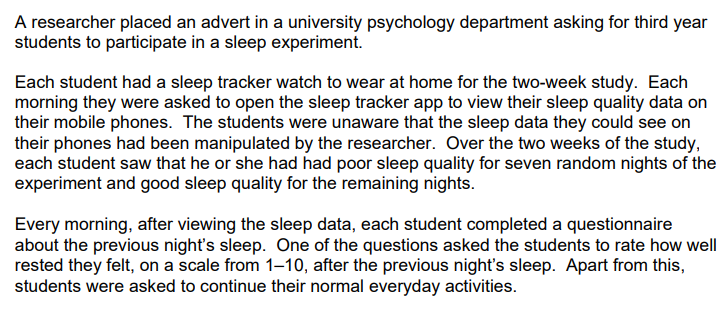
Write a directional hypothesis the researcher might use for this study. (3)
The students will have a lower rated score on the scale of 1-10 of how rested they felt when they had bad sleep data compared to when they had good sleep data
11
New cards
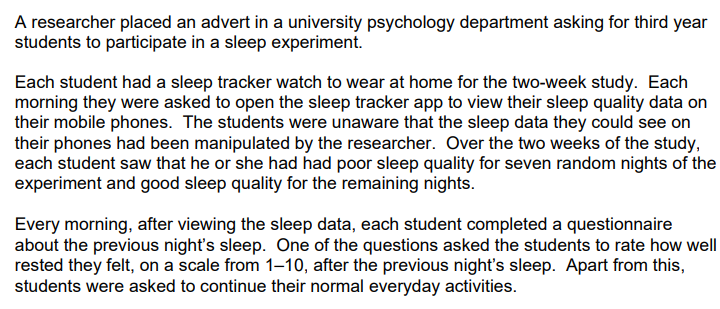
Write a directional hypothesis the researcher might use for this study. (1)
D - volunteer sampling
12
New cards
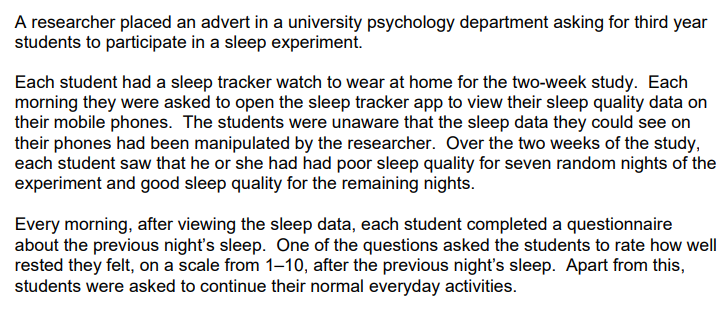
Explain one strength and one limitation of using a volunteer sampling method in this study. (4)
Strength:
* the method is not time consuming as the researcher only had to put up a poster at the university and wait for students to volunteer
* the students will be happy and willing to participate so will be more likely to complete the daily sleep questionnaire
\
Limitation:
* it produces a biased sample as it would only include psychology students from one university which does not reflect the rest of the population as they are all of similar age and education level
* the method is not time consuming as the researcher only had to put up a poster at the university and wait for students to volunteer
* the students will be happy and willing to participate so will be more likely to complete the daily sleep questionnaire
\
Limitation:
* it produces a biased sample as it would only include psychology students from one university which does not reflect the rest of the population as they are all of similar age and education level
13
New cards
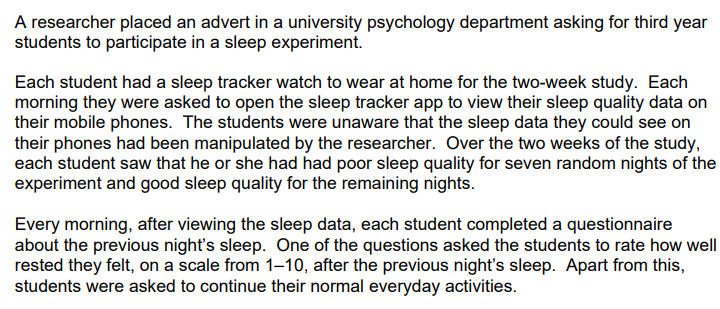
The researcher collected quantitative data about how well rested the students felt
\
Explain one strength of collecting quantitative data in this study. (2)
\
Explain one strength of collecting quantitative data in this study. (2)
It means that the sleep data can be analysed more easily as the scores can be put into a table or a graph and can be easily compared across the participants
14
New cards
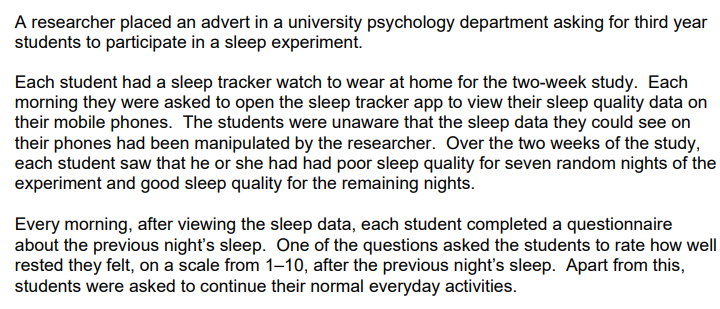
One ethical issue in this study is deception, as the students were unaware that the sleep data they could see on their phones had been manipulated by the researcher.
Explain one way in which the researcher might deal with the deception in this study (2)
Explain one way in which the researcher might deal with the deception in this study (2)
the researcher could debrief the participants at the end of the study and tell them about the sleep data and aims of the study and then give them the option to withdraw their data if they want to
15
New cards
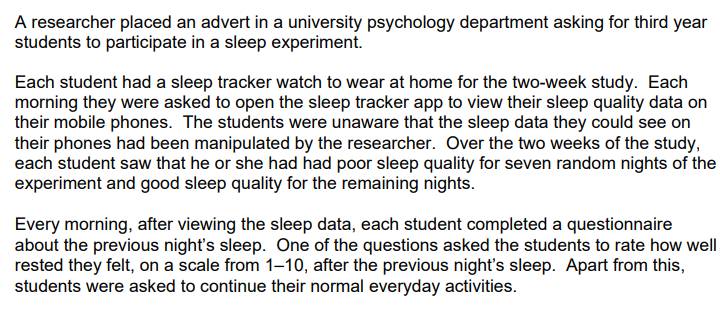
Apart from the question about how well rested the students felt, the researcher’s questionnaire contained nine other questions. The responses to these questions were not analysed.
\
Explain one reason why the researcher decided to include these additional questions on the questionnaire. (2)
\
Explain one reason why the researcher decided to include these additional questions on the questionnaire. (2)
because the additional questions might have distracted the students from realising that the focus of the study was on their perceived quality of sleep (scale 1-10). Therefore the students are less likely to guess the aims of the study and alter their sleep ratings. Therefore reducing the demand characteristics and improving the validity
16
New cards
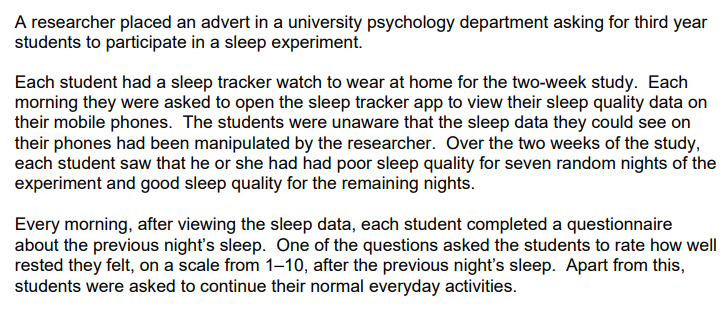
Explain one limitation of assessing sleep quality using a rating scale of 1–10. (2)
because it is subjective. one persons view of good sleep (10) could be very different to someones else’s view on what good sleep is
17
New cards
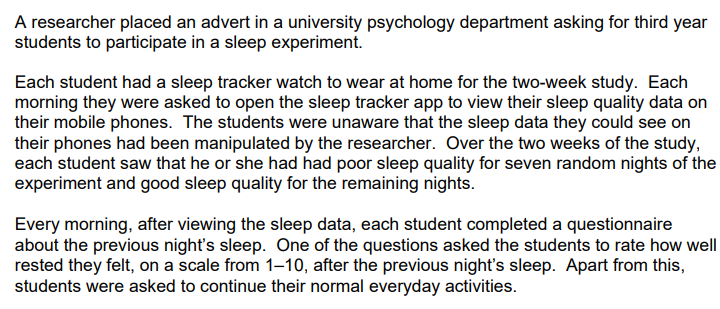
The researcher believed that the actual number of hours slept by the students could have affected the results of the study
\
Suggest one other extraneous variable that could have affected the results of this study. Explain why it would have been important to control this extraneous variable and how it could have been controlled in this study. (4)
\
Suggest one other extraneous variable that could have affected the results of this study. Explain why it would have been important to control this extraneous variable and how it could have been controlled in this study. (4)
the consumption of alcohol or caffeine before they go to sleep. This can make them feel worse in the morning making them give a lower score regardless of the sleep tracking data therefore decreasing the validity of the study.
This can be controlled by telling the students to not take any stimulants or depressants such as alcohol or caffeine in the evenings of the study
\
This can be controlled by telling the students to not take any stimulants or depressants such as alcohol or caffeine in the evenings of the study
\
18
New cards
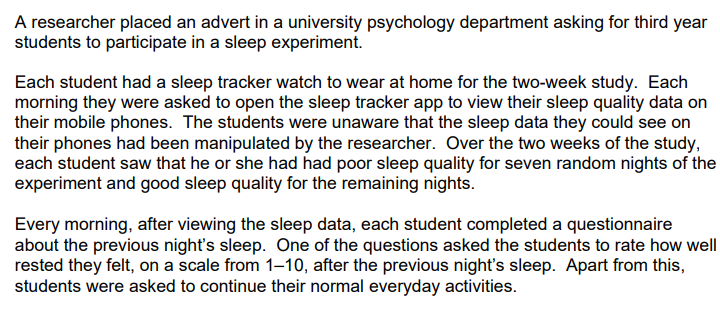
In a follow-up study, the researcher investigated whether there was a correlation between box the number of hours slept and how well rested the students felt. The researcher randomly selected 18 participants from first-year students at the university. On the day of the study, each student participant was asked, ‘How many hours did you sleep last night?’ They then had to rate on a scale of 1 to 5 how well rested they felt. The researcher hypothesised that there would be a positive correlation between the two co-variables.
\
Outline one reason why it was appropriate to conduct a correlation rather than an experiment in this case. (2)
\
Outline one reason why it was appropriate to conduct a correlation rather than an experiment in this case. (2)
it would be more ethical to do a correlation rather than an experiment because the researcher doesn’t have to restrict the number of hours each student sleeps for
19
New cards
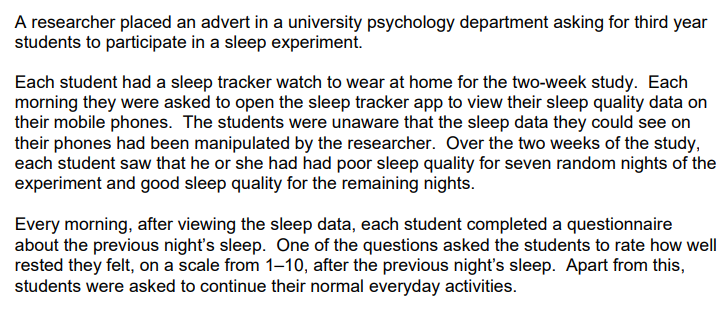
Describe how the researcher could have used random sampling to obtain the students for this study (3)
* collect the names of all the 1st year students at the university
* put all the names into a hat
* pull the names randomly out of the hat
* repeat until 18 names have been selected
* put all the names into a hat
* pull the names randomly out of the hat
* repeat until 18 names have been selected
20
New cards
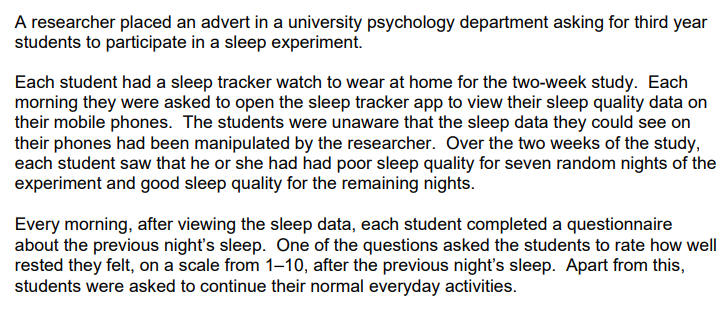
The researcher used Spearman’s rho statistical test to analyse the data from this study
Explain why Spearman’s rho was a suitable test for this study. Refer to the description of the study in your answer. (4)
Explain why Spearman’s rho was a suitable test for this study. Refer to the description of the study in your answer. (4)
because it was a test of correlation between the number of hours slept and how well rested they felt. As well as that they used ordinal data because the data collected was a score on a scale of 1-5 which can be ranked, therefore spearman’s is the appropriate test to use
21
New cards
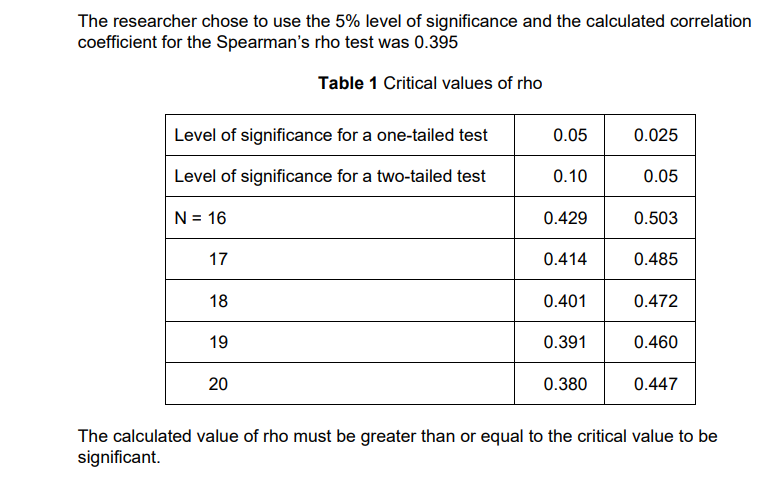
Identify the appropriate critical value from Table 1. Explain your choice (4)
the critical value is **0.401.** This is because:
* the researcher chose to use 5% level of significance so you use the 0.05 column
* it is a one tailed test because the hypothesis is directional so you use the first column
* then there are 18 participants so n=18
* the researcher chose to use 5% level of significance so you use the 0.05 column
* it is a one tailed test because the hypothesis is directional so you use the first column
* then there are 18 participants so n=18
22
New cards
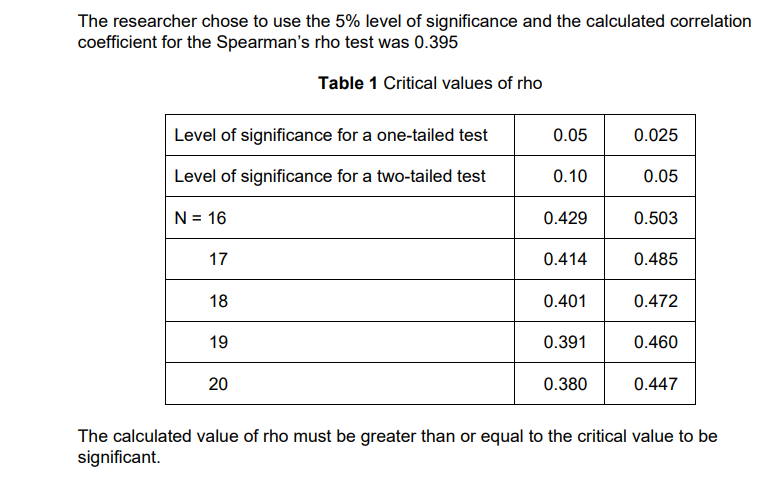
Explain whether the researcher’s hypothesis should be accepted. Refer to the critical value identified in Question 21 in your answer. (2)
no because the calculated value of 0.395 is less than the critical value of 0.401
23
New cards
Explain why the researcher decided to use the 5% level of significance rather than the 1% level in this study (2)
because it reduces the risk of type I and type II errors and investigating the number of hours slept and how well rested you feel is not a sensitive or ethical topic so 5% is the best level to use
\
\
24
New cards
When the researcher compared the calculated and critical values of rho, he began to wonder if he might have made a Type II error
\
Explain what is meant by a Type II error in the context of this study (2)
\
Explain what is meant by a Type II error in the context of this study (2)
when the researcher accepts there is no correlation between the number of hours slept and how well rested they felt (null hypothesis) even though the alternative hypothesis is correct
25
New cards
Discuss features of science. Refer to one or more examples of psychological research in your answer. (8)
Empiricism
* The empirical method is a research process to obtain information using observable evidence to draw conclusions. These conclusions are what researchers use to build and propose theories.
* The empirical method provides a systematic way to collect, analyse, and organise data and aims to differentiate between scientific facts and opinions about phenomena
* Therefore uses data that is objective. Objective research that follows the empirical method can indicate that certain research findings have high validity.
* ==It gives a means for others to test the theory to help identify whether the findings are truthful==
Replicability
* Scientific research needs to be replicable. Research findings must be tested repeatedly to identify if they are reliable.
* We assess the reliability of research by identifying if we found consistent results when we repeat the same study with different participants, in various settings, and at different times.
* ==It is problematic if replicated research differs in terms of the sample or the setting differed in results. The results are inconsistent, so how do we know which is correct?==
Falsifiability
* Karl Popper (1934) proposed the theory of falsifiability. He suggested that to regard research as scientific, theories/hypotheses should be:
* Testable.
* Able to be proven wrong.
* Observable and able to be tested via experimental/observational methods.
* Based on objective facts rather than subjective opinions.
Paradigms
* Paradigms are a way of looking at something. Psychologists decide which standpoint is the 'best' perspective or approach to take when investigating psychological phenomena.
* a paradigm is a set of shared beliefs and methods within a scientific discipline
* a shift occurs in a scientific revolution when there is too much evidence to ignore
\
%%Kuhn’s theory:%%
* %%Step 1 - there is an accepted paradigm.%%
* %%Step 2 - there is a crisis%%
* %%A crisis arises when a paradigm can no longer explain phenomena or anomalies found; this causes a scientific revolution.%%
* %%Step 3 - there is a paradigm shift.%%
* %%The shift occurs when a new paradigm is accepted because it can explain phenomena better and the anomalies.%%
* The empirical method is a research process to obtain information using observable evidence to draw conclusions. These conclusions are what researchers use to build and propose theories.
* The empirical method provides a systematic way to collect, analyse, and organise data and aims to differentiate between scientific facts and opinions about phenomena
* Therefore uses data that is objective. Objective research that follows the empirical method can indicate that certain research findings have high validity.
* ==It gives a means for others to test the theory to help identify whether the findings are truthful==
Replicability
* Scientific research needs to be replicable. Research findings must be tested repeatedly to identify if they are reliable.
* We assess the reliability of research by identifying if we found consistent results when we repeat the same study with different participants, in various settings, and at different times.
* ==It is problematic if replicated research differs in terms of the sample or the setting differed in results. The results are inconsistent, so how do we know which is correct?==
Falsifiability
* Karl Popper (1934) proposed the theory of falsifiability. He suggested that to regard research as scientific, theories/hypotheses should be:
* Testable.
* Able to be proven wrong.
* Observable and able to be tested via experimental/observational methods.
* Based on objective facts rather than subjective opinions.
Paradigms
* Paradigms are a way of looking at something. Psychologists decide which standpoint is the 'best' perspective or approach to take when investigating psychological phenomena.
* a paradigm is a set of shared beliefs and methods within a scientific discipline
* a shift occurs in a scientific revolution when there is too much evidence to ignore
\
%%Kuhn’s theory:%%
* %%Step 1 - there is an accepted paradigm.%%
* %%Step 2 - there is a crisis%%
* %%A crisis arises when a paradigm can no longer explain phenomena or anomalies found; this causes a scientific revolution.%%
* %%Step 3 - there is a paradigm shift.%%
* %%The shift occurs when a new paradigm is accepted because it can explain phenomena better and the anomalies.%%
26
New cards
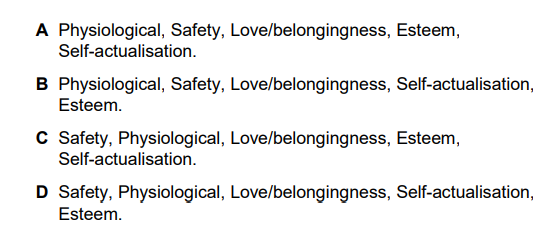
What is the correct arrangement of Maslow’s hierarchy of needs from bottom to top of the hierarchy? (1)
A
27
New cards
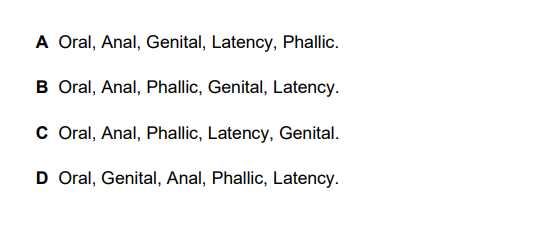
Which of the following shows the correct order of the psycho sexual stages of development as proposed by the psychodynamic approach? (1)
C
28
New cards
Describe the role of defence mechanisms according to the psychodynamic approach (2)
they are unconscious strategies that are used by the ego to manage the conflict between the id and the superego
for example through the use of denial, repression and displacement
for example through the use of denial, repression and displacement
29
New cards
Briefly explain one strength and one limitation of the psychodynamic approach. (4)
A strength is that the theory has had practical application in therapy. Psychotherapy has been developed as a treatment for mental health issues by accessing the unconscious e.g by hypnosis
A limitation is that Freud used the case study method; therefore his findings are not representative as they are only based on a small number of individuals who were psychologically abnormal because they were in therapy
A limitation is that Freud used the case study method; therefore his findings are not representative as they are only based on a small number of individuals who were psychologically abnormal because they were in therapy
30
New cards

Describe and evaluate operant conditioning as a way of explaining people’s behaviour. Refer to Alison’s approach to reducing plastic waste in your answer (16)
* Operant conditioning is a form of learning which states that behaviour is shaped and maintained by its consequences. Alison uses two types of operant conditioning.
* The first is positive reinforcement, which is described as receiving a reward when a desired behaviour is performed. The rewards act as an incentive to keep doing this behaviour, therefore, increasing the likelihood that the behaviour will be repeated. This is displayed by Alison who offers free refills for students with their own bottles and sets up a desk where students can get 20 pence back for handing in a plastic bottle to be recycled. Students are therefore rewarded if they keep using their own plastic bottles and collect plastic litter. The reward encourages the students to keep using their own bottles and cleaning the school environment, therefore repeating positive behaviours.
* The second type is negative reinforcement, this occurs when someone behaves in a certain way to avoid something unpleasant. This can be seen by Alison who, in order to reduce plastic waste, increases the price of bottled water to 20 pence. Students are therefore, more likely to avoid buying plastic bottles since they are now more expensive, increasing the likelihood they will bring their own bottles. Alison also utilises negative reinforcement by putting a sticker showing an ocean of plastic waste on each plastic bottle in the canteen. Students may want to avoid the consequence of contributing to the plastic waste, reinforcing the behaviour of not buying plastic bottles.
\
* Operant conditioning has research support from Skinner (1948) who studied rats, he devised a highly controlled, lab study in which a rat was put in a box with a lever; every time the rat accidentally pushed the lever a food pellet would be dispensed - a reward. The rat would then continue to push the lever to get the reward, therefore the behaviour was positively reinforced and repeated. This suggests that an action can be reinforced as a result of being rewarded and that people will do the same. There is however, an issue with this study in that Skinner used rats, thus responses to stimuli may not be able to be applied accurately to humans as animal behaviour may be different to humans, therefore it lacks generalisability.
* A strength of operant conditioning is its real-life applications. It is the basis for token economy systems that have been used by psychiatric wards and also with Alison who is using it to reduce plastic waste. This is a strength as it shows that peoples behaviours are influenced by this and that operant conditioning is effective
* Furthermore, the approach has an over-reliance on animal studies such as this therefore, it may lack validity.
* Another issue of operant conditioning is its mechanistic view of behaviour. It is also deterministic as it views the mind as a 'black box' with no free will and it is based on a stimulus-response framework which doesn't allow for true application to the real world, which is more dynamic and complex than the linear view operant conditioning has towards learning, meaning students may have other factors that are not accounted for by the approach such as price of water not being an issue This is an issue since it is reductionist, not looking at behaviour as the sum of multiple factors thus, can only explain certain types of behaviour.
* The first is positive reinforcement, which is described as receiving a reward when a desired behaviour is performed. The rewards act as an incentive to keep doing this behaviour, therefore, increasing the likelihood that the behaviour will be repeated. This is displayed by Alison who offers free refills for students with their own bottles and sets up a desk where students can get 20 pence back for handing in a plastic bottle to be recycled. Students are therefore rewarded if they keep using their own plastic bottles and collect plastic litter. The reward encourages the students to keep using their own bottles and cleaning the school environment, therefore repeating positive behaviours.
* The second type is negative reinforcement, this occurs when someone behaves in a certain way to avoid something unpleasant. This can be seen by Alison who, in order to reduce plastic waste, increases the price of bottled water to 20 pence. Students are therefore, more likely to avoid buying plastic bottles since they are now more expensive, increasing the likelihood they will bring their own bottles. Alison also utilises negative reinforcement by putting a sticker showing an ocean of plastic waste on each plastic bottle in the canteen. Students may want to avoid the consequence of contributing to the plastic waste, reinforcing the behaviour of not buying plastic bottles.
\
* Operant conditioning has research support from Skinner (1948) who studied rats, he devised a highly controlled, lab study in which a rat was put in a box with a lever; every time the rat accidentally pushed the lever a food pellet would be dispensed - a reward. The rat would then continue to push the lever to get the reward, therefore the behaviour was positively reinforced and repeated. This suggests that an action can be reinforced as a result of being rewarded and that people will do the same. There is however, an issue with this study in that Skinner used rats, thus responses to stimuli may not be able to be applied accurately to humans as animal behaviour may be different to humans, therefore it lacks generalisability.
* A strength of operant conditioning is its real-life applications. It is the basis for token economy systems that have been used by psychiatric wards and also with Alison who is using it to reduce plastic waste. This is a strength as it shows that peoples behaviours are influenced by this and that operant conditioning is effective
* Furthermore, the approach has an over-reliance on animal studies such as this therefore, it may lack validity.
* Another issue of operant conditioning is its mechanistic view of behaviour. It is also deterministic as it views the mind as a 'black box' with no free will and it is based on a stimulus-response framework which doesn't allow for true application to the real world, which is more dynamic and complex than the linear view operant conditioning has towards learning, meaning students may have other factors that are not accounted for by the approach such as price of water not being an issue This is an issue since it is reductionist, not looking at behaviour as the sum of multiple factors thus, can only explain certain types of behaviour.
31
New cards
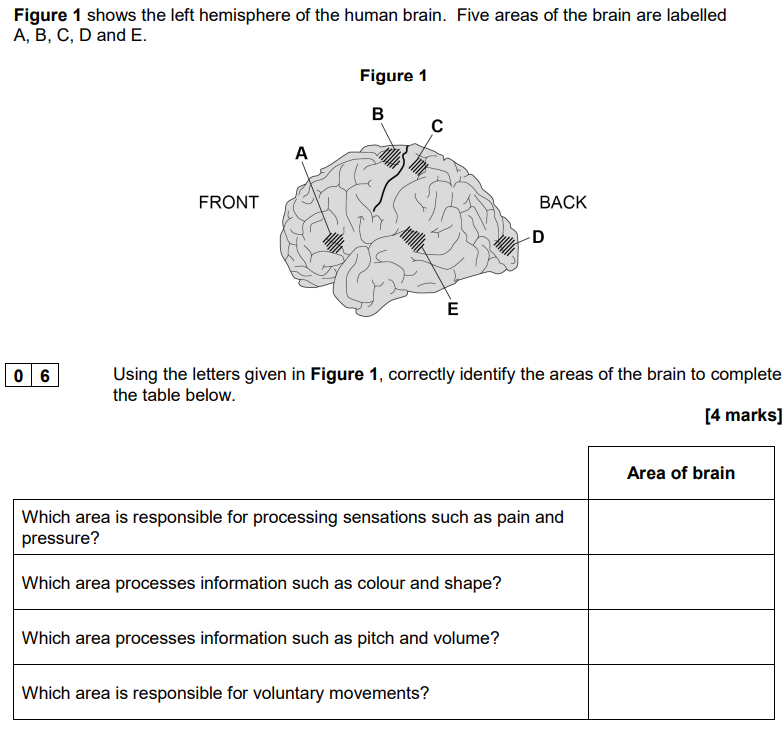
Using the letters given in Figure 1, correctly identify the areas of the brain to complete the table below. (4)
\
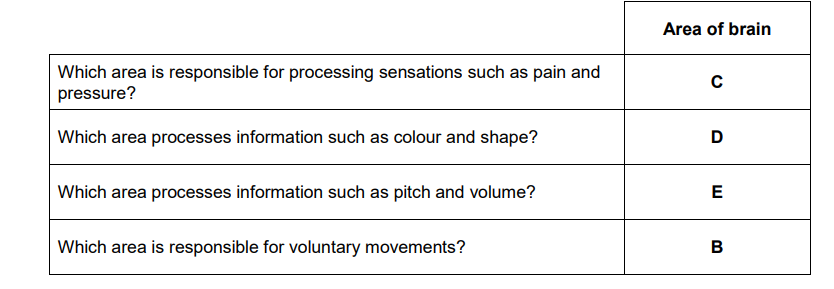
32
New cards
Explain the difference between infradian rhythms and ultradian rhythms. (2)
infradian rhythms occur over more than 24 hours and ultradian rhythms are less than 24 hours
33
New cards
A survey of hospital patients has found that a new drug, Zapurpain, is as effective as other pain medication. Explain one limitation of asking hospital patients to self-report the effectiveness of Zapurpain. (2)
social desirability bias - patients may feel obliged to say that the drug is effective in reducing their pain
34
New cards
Zapurpain acts like an inhibitory neurotransmitter at the synapse.
\
Explain how Zapurpain might affect the process of synaptic transmission through inhibition (4)
\
Explain how Zapurpain might affect the process of synaptic transmission through inhibition (4)
* Explain how Zapurpain might affect the process of synaptic transmission through inhibition
* it binds to the post-synaptic receptors it makes the post-synaptic cell less likely to fire
* zapurpain would reduce the overall activity through summation
* it makes the post synaptic cell less likely to fire
* this will reduce the brain activity
* which will lead to reduced pain
* it binds to the post-synaptic receptors it makes the post-synaptic cell less likely to fire
* zapurpain would reduce the overall activity through summation
* it makes the post synaptic cell less likely to fire
* this will reduce the brain activity
* which will lead to reduced pain
35
New cards
Explain one difference and one similarity between Functional Magnetic Resonance box Imaging (fMRI) and Event-Related Potentials (ERPs) as ways of studying the brain (4)
* fMRI have poor temporal resolution whereas ERPs have good temporal resolution
* they are both non invasive and don’t use radiation
* they are both non invasive and don’t use radiation
36
New cards
Outline and evaluate split-brain research. (8)
**Hemispheric lateralisation:** This is the ideas that the brain’s two hemispheres are responsible for different functions; that particular functions (such as language) are the responsibility of one hemisphere but not the other- the function is lateralised.
**Split-brain research:** This involves individuals who have had surgical separation of their brain hemispheres, in order to relieve symptoms of epilepsy. Research can reveal to what extent other brain functions are lateralised. Sperry (1968) used a procedure where an image or word was projected to the patient’s right visual field (which would be processed by the left hemisphere) and another image was projected to the left visual field (processed by the right hemisphere). In a split-brain patient, information cannot be transmitted from one hemisphere to another, so the effects of this can be studied.
**Findings from split-brain research:** When a picture was shown to the right visual field, the patient could describe it easily. When the image was shown to the left visual field, the patient found it difficult to describe it, or couldn’t see anything there. This is likely due to the lack of language processing ability in the right hemisphere, which processes the left visual field. The left hemisphere was unable to receive the information due to the separation of the hemispheres.
When patients were presented with a word or object in the left visual field, then had to select that object (or a related one) from a bag using their left hand without looking, they were able to do this quite well. This is despite the fact that they couldn’t describe what the object was. They could still seemingly understand what the object was, showing that the right hemisphere is involved in understanding of objects.
When patients were presented with two words simultaneously (for example, ‘door’ ‘frame’), one in each visual field, they wrote the word in the left visual field (‘door’) with their left hand, and said the word in the right visual field (‘frame’). The left hand was much better at drawing images than the right hand, despite the fact that all of the patients tested were right-handed. This shows that the right hemisphere seems to be dominant for drawing skills.
When asked to match a face from a number of other faces, the picture presented to the left visual field (processed by the right hemisphere) was consistently selected, whilst the image presented to the right visual field (left hemisphere) was ignored. This shows that the right hemisphere seems dominant in face recognition. Images presented as composites of two faces led to the left hemisphere dominating when the patient was asked to verbally describe the face (the right-hand ‘half’ of the face was described, and the left-hand half ignored), and the right hemisphere dominated when the patient had to select a matching face from a number of others.
\
**Evaluation:**
* Sperry’s research supports the conclusion that the left hemisphere is more responsible for verbal and analytical tasks, whereas the right hemisphere is better at spatial and musical tasks. This has strengthened the understanding of how the brain works.
* Sperry’s procedure was closely controlled. Patients were given eye patches, and images were flashed up for a very brief time (fractions of a second), meaning there was no possibility of looking over and using the other visual field. This strengthens the internal validity of the studies.
* The sample used by Sperry was quite small (only 11 took part in all procedures), and their brains may have been affected by epileptic seizures. Therefore, it is hard to generalise the findings from the studies to the general population.
**Split-brain research:** This involves individuals who have had surgical separation of their brain hemispheres, in order to relieve symptoms of epilepsy. Research can reveal to what extent other brain functions are lateralised. Sperry (1968) used a procedure where an image or word was projected to the patient’s right visual field (which would be processed by the left hemisphere) and another image was projected to the left visual field (processed by the right hemisphere). In a split-brain patient, information cannot be transmitted from one hemisphere to another, so the effects of this can be studied.
**Findings from split-brain research:** When a picture was shown to the right visual field, the patient could describe it easily. When the image was shown to the left visual field, the patient found it difficult to describe it, or couldn’t see anything there. This is likely due to the lack of language processing ability in the right hemisphere, which processes the left visual field. The left hemisphere was unable to receive the information due to the separation of the hemispheres.
When patients were presented with a word or object in the left visual field, then had to select that object (or a related one) from a bag using their left hand without looking, they were able to do this quite well. This is despite the fact that they couldn’t describe what the object was. They could still seemingly understand what the object was, showing that the right hemisphere is involved in understanding of objects.
When patients were presented with two words simultaneously (for example, ‘door’ ‘frame’), one in each visual field, they wrote the word in the left visual field (‘door’) with their left hand, and said the word in the right visual field (‘frame’). The left hand was much better at drawing images than the right hand, despite the fact that all of the patients tested were right-handed. This shows that the right hemisphere seems to be dominant for drawing skills.
When asked to match a face from a number of other faces, the picture presented to the left visual field (processed by the right hemisphere) was consistently selected, whilst the image presented to the right visual field (left hemisphere) was ignored. This shows that the right hemisphere seems dominant in face recognition. Images presented as composites of two faces led to the left hemisphere dominating when the patient was asked to verbally describe the face (the right-hand ‘half’ of the face was described, and the left-hand half ignored), and the right hemisphere dominated when the patient had to select a matching face from a number of others.
\
**Evaluation:**
* Sperry’s research supports the conclusion that the left hemisphere is more responsible for verbal and analytical tasks, whereas the right hemisphere is better at spatial and musical tasks. This has strengthened the understanding of how the brain works.
* Sperry’s procedure was closely controlled. Patients were given eye patches, and images were flashed up for a very brief time (fractions of a second), meaning there was no possibility of looking over and using the other visual field. This strengthens the internal validity of the studies.
* The sample used by Sperry was quite small (only 11 took part in all procedures), and their brains may have been affected by epileptic seizures. Therefore, it is hard to generalise the findings from the studies to the general population.
37
New cards
In which section(s) of a scientific report would you expect to find reference to the results/findings of the investigation? (1)
B - the abstract, the discussion and the results section only
38
New cards
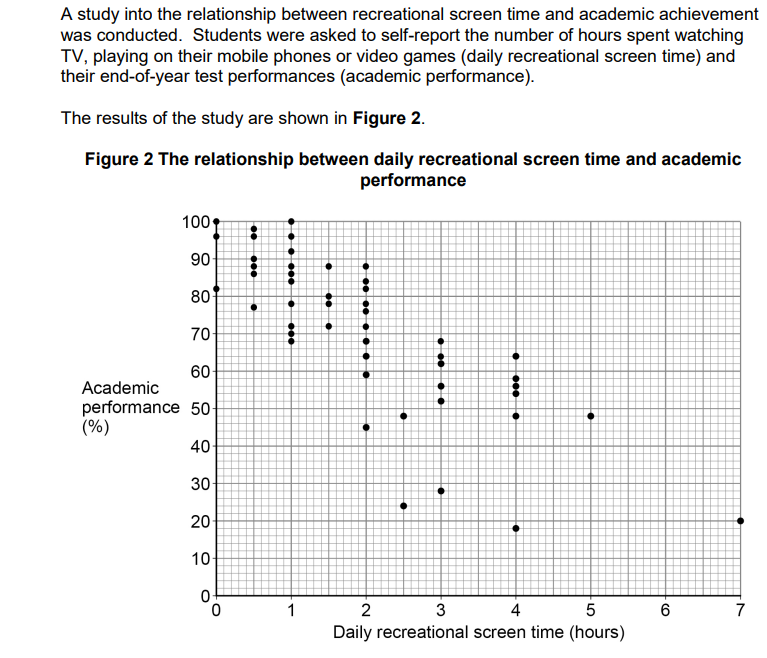
Identify the type of graph shown in Figure 2 and explain why this is an appropriate graph to use for the data collected. (3)
* scatter graph
* the study is correlational/looking at the relationship between recreational screen time and academic performance, scatter grams display relationships between co-variables, academic performance and recreational screen time are co-variables.
* the study is correlational/looking at the relationship between recreational screen time and academic performance, scatter grams display relationships between co-variables, academic performance and recreational screen time are co-variables.
39
New cards
Explain why it would not be appropriate for the researchers to conclude that increased recreational screen time reduces academic performance. (2)
because its a correlation between the two co variables of recreational screen time and academic performance. Therefore you cant say that one causes the other
40
New cards
What is meant by the term meta-analysis? (2)
* meta-analysis is the process where researchers collect and collate a wide range of previously conducted research on a specific area
* collated research is reviewed together
* combined data/effect size is often statistically tested to provide an overall conclusion.
* collated research is reviewed together
* combined data/effect size is often statistically tested to provide an overall conclusion.
41
New cards
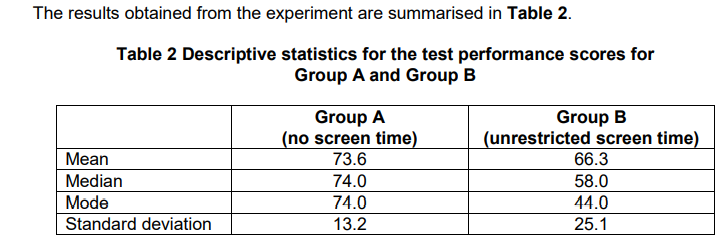
Using the data in Table 2, explain how the distribution of scores in Group A differs from the distribution of scores in Group B. (4)
* the data in Group A is symmetrical/normally distributed
* because the mean (73.6) is approximately equal to the mode and median (74)
* the data in Group B is positively skewed
* because the mean (66.3) is greater than the mode (44) and the median (58)
* because the mean (73.6) is approximately equal to the mode and median (74)
* the data in Group B is positively skewed
* because the mean (66.3) is greater than the mode (44) and the median (58)
42
New cards
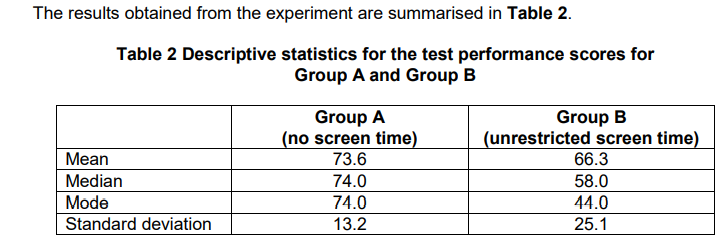
What do the mean and standard deviation values in Table 2 suggest about the effect of box the recreational screen time on test performance? Justify your answer. (4)
The mean suggests that recreational screen time has a negative impact on test performance. This is because mean test performance is higher when there is no recreational screen time (Group A) than when recreational screen time is unrestricted (Group B)
\
The standard deviation suggests that the impact of recreational screen time on test performance is not consistent. This is because there was a wider variation of test performances / higher standard deviation in Group B compared to Group A.
\
The standard deviation suggests that the impact of recreational screen time on test performance is not consistent. This is because there was a wider variation of test performances / higher standard deviation in Group B compared to Group A.
43
New cards
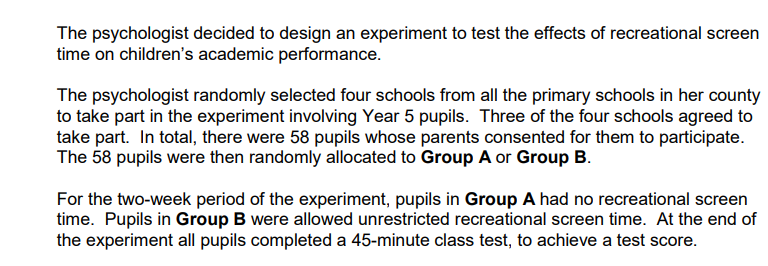
The psychologist wanted to test the statistical significance of the data. Identify the most appropriate choice of statistical test for analysing the data collected and explain three reasons for your choice in the context of this study. (7)
Mann-Whitney
* it is testing for a difference - having no recreational screen time on exam performance as opposed to having unlimited recreational screen time
* it uses an independent/unrelated design – the pupils either had no recreational screen time or unlimited recreational screen time
* data is ordinal – the difference between each test score is not fixed OR data is assumed to be nonparametric as the data in Group B is skewed
* it is testing for a difference - having no recreational screen time on exam performance as opposed to having unlimited recreational screen time
* it uses an independent/unrelated design – the pupils either had no recreational screen time or unlimited recreational screen time
* data is ordinal – the difference between each test score is not fixed OR data is assumed to be nonparametric as the data in Group B is skewed
44
New cards
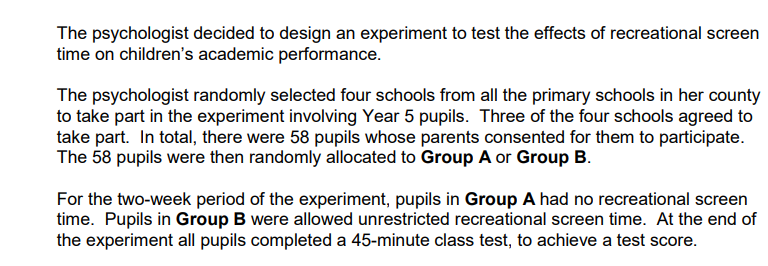
One criticism of the study is that the pupils were not matched on their typical recreational screen time.
Explain how the psychologist could have matched pupils on their typical recreational screen time across the experimental conditions. (4)
Explain how the psychologist could have matched pupils on their typical recreational screen time across the experimental conditions. (4)
* the psychologist could use a questionnaire/interview/ask parents to report/pupils to self-report
* examples of questions given/data obtained on average/daily recreational screen time use
* pupils with similar recreational screen time use would be paired
* one pupil from each pair would be (randomly) placed in Group A and the other in Group B
* examples of questions given/data obtained on average/daily recreational screen time use
* pupils with similar recreational screen time use would be paired
* one pupil from each pair would be (randomly) placed in Group A and the other in Group B
45
New cards

Identify one other variable for which the psychologist could have matched the pupils. Explain how this might have affected the test performance if it was not controlled. (2)
They could be matched on academic performance.
46
New cards
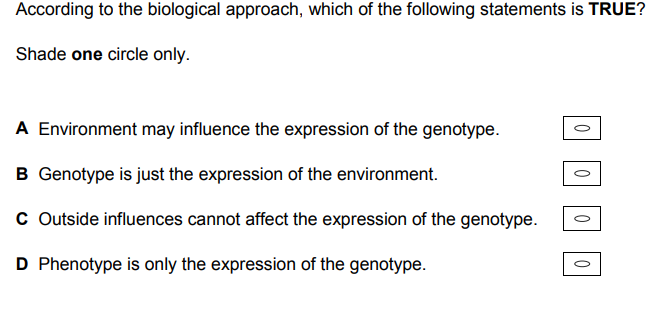
According to the biological approach, which of the following statements is TRUE? (1)
A - environment may influence the expression of the genotype
47
New cards
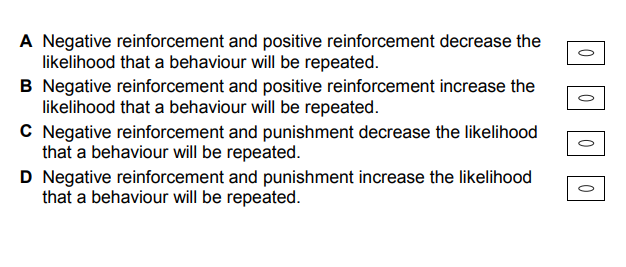
According to operant conditioning, which of the following statements is TRUE? (1)
B - Negative reinforcement and positive reinforcement increase the likelihood that a behaviour will be repeated.
48
New cards
Briefly describe one role of the unconscious according to the psychodynamic approach (2)
the unconscious is the driving force behind our behaviour. For example defence mechanisms, eg repression, denial, displacement, are used unconsciously to reduce anxiety
49
New cards

Explain how the Tiger advert might influence viewers’ mediational processes. (6)
The advert may influence viewers mediational processes through the fact that the use of a famous rugby player in the advert is likely to capture the viewers’ attention. As the advert may be considered to be amusing, in the way that the rugby player draws stripes on their face, it is likely that this memory will be retained in the long-term store. The action of simply spraying the stain and wiping it clean is one that is easy to copy, so this will aid in motor reproduction. In addition, the use of vicarious reinforcement is evident as the boy claps, this reward will motivate individuals to want to carry out the behaviour themselves.
50
New cards
The company paid the rugby player a lot of money to be in the advert. Use your knowledge of social learning theory to explain why the company wanted to use a famous rugby player in the advert. (2)
* people are more likely to identify with high status/highly attractive/celebrity role models
* therefore sales should increase/people are more likely to imitate the rugby player.
* therefore sales should increase/people are more likely to imitate the rugby player.
51
New cards
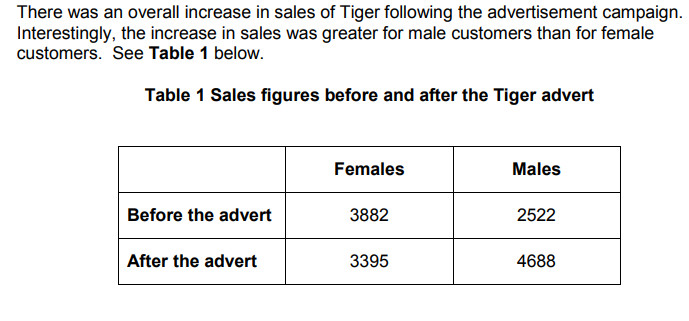
Calculate the percentage increase in sales of Tiger to male customers. Give your answer to two significant figures. (3)
(new - old) / old x 100
(4688-2522) / 2522 x 100 = 86%
(4688-2522) / 2522 x 100 = 86%
52
New cards

Using your knowledge of social learning theory, suggest how the advert could be modified to increase the sales of Tiger to female customers (1)
a female actor should be used in the advert
53
New cards
Outline and evaluate Wundt’s role in the emergence of psychology as a science. (8)
Wilhelm Wundt was responsible for a number of ‘firsts’ in the study of Psychology. He was the first psychologist to set up a specialised laboratory to study the mind and behaviour, this was known as the Institute of Experimental Psychology. In this controlled setting he was able to study the building blocks of human thought known as structuralism. He achieved through carrying out a number of experiments using introspection with his students, these experiments served to examine the role conscious thoughts and emotions in a scientific way.
Although Wundt’s methods of exploring introspection have been criticised due to the rather subjective nature of the research, that is to say that Wundt was attempting to study something that was unobservable, it is worth noting that Wundt went to great lengths to ensure that all of his students were highly skilled in such methods. This in part goes some way to reduce criticisms and serves to make his methods more objective.
Another issue related to the scientific nature of Wundt’s research is the issues with replicability. The ability to be able to carry out research and then repeat such research is a core principle of science and allows us to establish the reliability of conclusions. Arguably there is little research evidence outside of Wundt’s own work that has been able to produce similar results using the introspective methods. That being said, it is evident from more modern approaches, that the mental processes that Wundt was trying to study using introspection are indeed a valid constituent part of the human mind.
Although Wundt’s methods of exploring introspection have been criticised due to the rather subjective nature of the research, that is to say that Wundt was attempting to study something that was unobservable, it is worth noting that Wundt went to great lengths to ensure that all of his students were highly skilled in such methods. This in part goes some way to reduce criticisms and serves to make his methods more objective.
Another issue related to the scientific nature of Wundt’s research is the issues with replicability. The ability to be able to carry out research and then repeat such research is a core principle of science and allows us to establish the reliability of conclusions. Arguably there is little research evidence outside of Wundt’s own work that has been able to produce similar results using the introspective methods. That being said, it is evident from more modern approaches, that the mental processes that Wundt was trying to study using introspection are indeed a valid constituent part of the human mind.
54
New cards
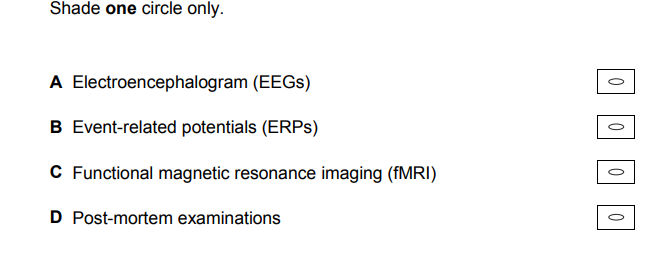
Which method of studying the brain would most accurately identify specific brain areas activated during a cognitive task? (1)
C
55
New cards
The adrenal gland is part of the endocrine system that produces adrenaline to help the body prepare for the fight or flight response.
Using an example of a gland and hormone, outline the function of the endocrine system. Do not use the adrenal gland/adrenaline as your example. (4)
Using an example of a gland and hormone, outline the function of the endocrine system. Do not use the adrenal gland/adrenaline as your example. (4)
* the endocrine system helps regulate the activity of cells and organs in the body
* it helps communicate chemical messages to the organs of the body
* the pineal gland produces melatonin, which may help regulate the wake-sleep cycle
* it helps communicate chemical messages to the organs of the body
* the pineal gland produces melatonin, which may help regulate the wake-sleep cycle
56
New cards

Discuss research into localisation of function in the brain and/or hemispheric lateralisation. Refer to Kieran and Sam’s discussion in your answer. (16)
Hemispheric lateralisation is the theory that the two halves of the cortex of the brain are functionally different and that each hemisphere has functional specialisations. The two hemispheres themselves are connected through a set of nerve fibres known as the corpus callosum, these fibres facilitate the communication between the left and right hemispheres of the brain. To research whether the left and right hemispheres of the brain have functional specialisms is difficult as the corpus callosum allows communication between the two hemispheres. This has led researchers to seek out patients whose corpus callosums, whether through, injury, genetics or surgery are not in-tact. For example, the research from Sperry’s select case of epileptic patients who had their corpus callosum removed to reduce seizures. Sperry’s research was able to demonstrate the functional speciality of the left and right hemispheres through the use of specialist equipment called a tachistoscope. Sperry presented words to either the left of right visual field. Owed to the contralateral configuration of the brain the words presented to the LVF would be processed in the right hemisphere and the words form the RVF in the left hemisphere. Sperry’s patients were able to verbally state words appearing to their LVF but not their right. This aligns with Broca’s assertion that the left hemisphere is responsible for language and speech.
\n
It is clear from Kieran’s comments about the left brain being responsible for certain tasks that he is referring to hemispheric lateralisation, that the brain is lateralised and certain sides of the cortex are individually responsible for certain function, such as Kieran says, the left hemisphere for speech and language where Broca and Wernicke’s area are located. Sam on the other hand is referring to how the two parts of the cortex, the left and right hemisphere are able to communicate with each other through a system of fibres known as the corpus callosum, when he refers to the whole brain working together.
\n
Although the work of Sperry and Broca supports the theory of hemispheric lateralisation, there is research that contradicts these findings. Interestingly the case study of Kim Peek, who was born without a corpus callosum demonstrated the Peek was able to read out-loud from a book from the right and left pages at the same time, if language was, like Broca and Sperry had argued, lateralised to the left hemisphere Peek would have only been able to read aloud the words from the right page. This criticism is further reinforced by Turn (2002) who discovered a patient who suffered damage to the left hemisphere, but developed the capacity to speak from the right hemisphere, eventually leading to the ability to speak about information presented to either side of the brain. This points to the fact that through a process of functionally recovery, lateralised functions may appear on opposing sides after injury.
\n
Another factor to consider in respect to hemispheric lateralisation is the degree to which the brain is lateralised. There is research by Shaywitz 1995 for example to support the idea that in males the brain may be more lateralised for language than in females. This is further supported by Baron Cohen 2005 who asserted that these gender differences in lateralisation may also contribute to the incidence of disorders such as ASD. Both of these pieces of research serve to demonstrate that hemispheric lateralisation is much more complex that Sperry and Broca’s research indicates.
\n
It is clear from Kieran’s comments about the left brain being responsible for certain tasks that he is referring to hemispheric lateralisation, that the brain is lateralised and certain sides of the cortex are individually responsible for certain function, such as Kieran says, the left hemisphere for speech and language where Broca and Wernicke’s area are located. Sam on the other hand is referring to how the two parts of the cortex, the left and right hemisphere are able to communicate with each other through a system of fibres known as the corpus callosum, when he refers to the whole brain working together.
\n
Although the work of Sperry and Broca supports the theory of hemispheric lateralisation, there is research that contradicts these findings. Interestingly the case study of Kim Peek, who was born without a corpus callosum demonstrated the Peek was able to read out-loud from a book from the right and left pages at the same time, if language was, like Broca and Sperry had argued, lateralised to the left hemisphere Peek would have only been able to read aloud the words from the right page. This criticism is further reinforced by Turn (2002) who discovered a patient who suffered damage to the left hemisphere, but developed the capacity to speak from the right hemisphere, eventually leading to the ability to speak about information presented to either side of the brain. This points to the fact that through a process of functionally recovery, lateralised functions may appear on opposing sides after injury.
\n
Another factor to consider in respect to hemispheric lateralisation is the degree to which the brain is lateralised. There is research by Shaywitz 1995 for example to support the idea that in males the brain may be more lateralised for language than in females. This is further supported by Baron Cohen 2005 who asserted that these gender differences in lateralisation may also contribute to the incidence of disorders such as ASD. Both of these pieces of research serve to demonstrate that hemispheric lateralisation is much more complex that Sperry and Broca’s research indicates.
57
New cards
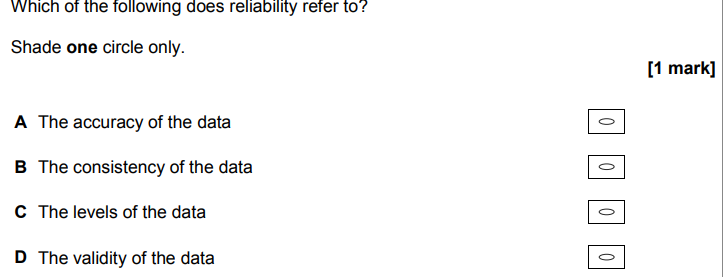
B
58
New cards
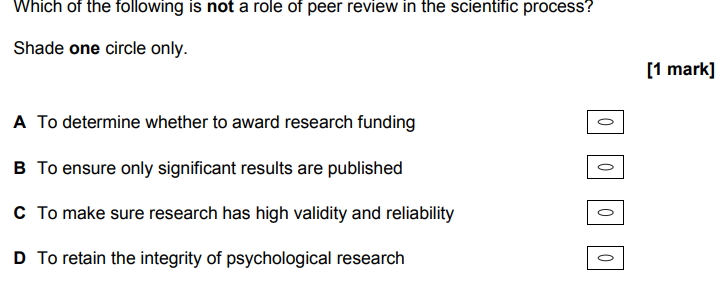
B
59
New cards
Give one reason why it is important for scientific reports to include a referencing section? (1)
to give credit to the researchers whose work they used
60
New cards
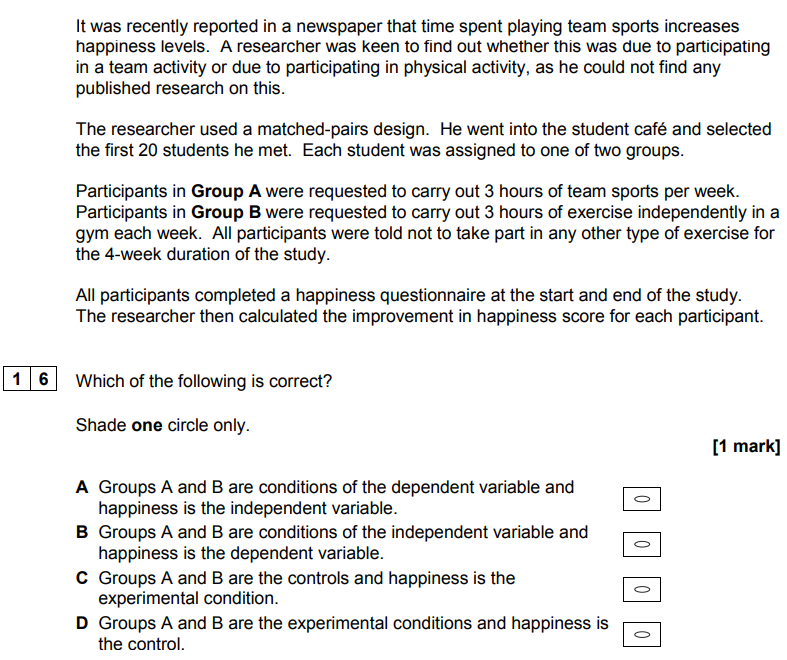
Which of the following is correct? (1)
B - Groups A and B are conditions of the independent variable and happiness is the dependent variable.
61
New cards
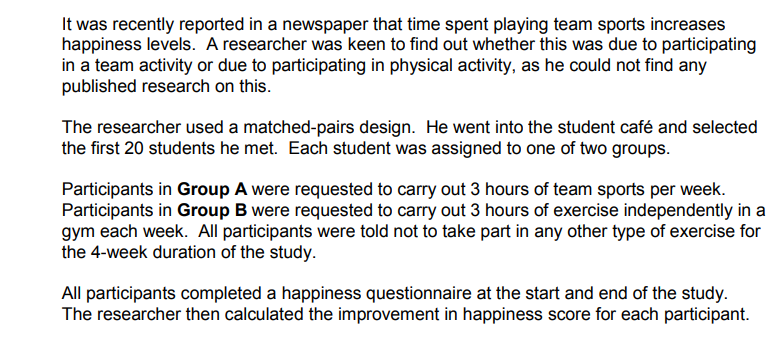
Would a directional or non-directional hypothesis be more suitable for the researcher to use? Explain your answer. (2)
non-directional because he could not find any published research on whether team activity or physical activity contributed to increased happiness levels. Therefore it is unclear what the outcome of the study will be so a non directional hypotheses would be more suitable
62
New cards
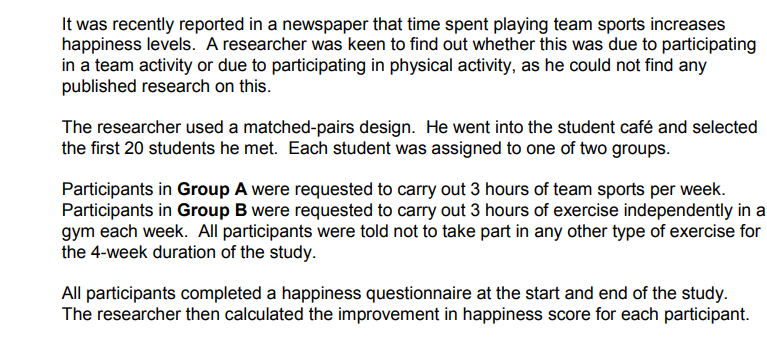
Write a suitable hypothesis for this experiment. (3)
There will be a difference in the improvement in happiness score after playing team sports than after independently exercising.
63
New cards
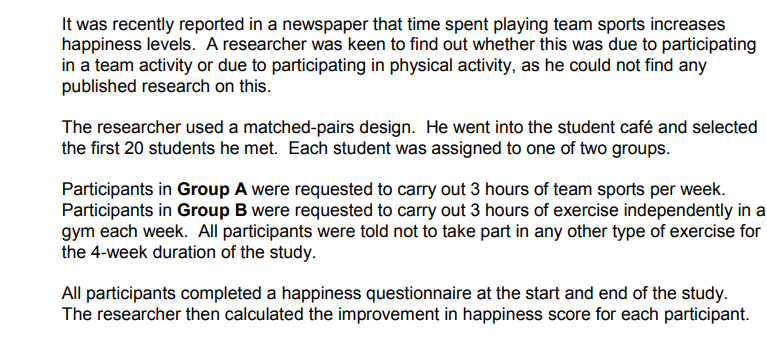
Identify the type of sampling method used in this experiment. Explain one limitation of using this sampling method in this study. (3)
* opportunity sampling
* a limitation of this method is that it is unrepresentative of the target population
* the students who are in a cafe might be more outgoing therefore may be more likely to enjoy team sports, providing a greater effect of team sports on happiness than if more introverted shy participants took part.
* a limitation of this method is that it is unrepresentative of the target population
* the students who are in a cafe might be more outgoing therefore may be more likely to enjoy team sports, providing a greater effect of team sports on happiness than if more introverted shy participants took part.
64
New cards
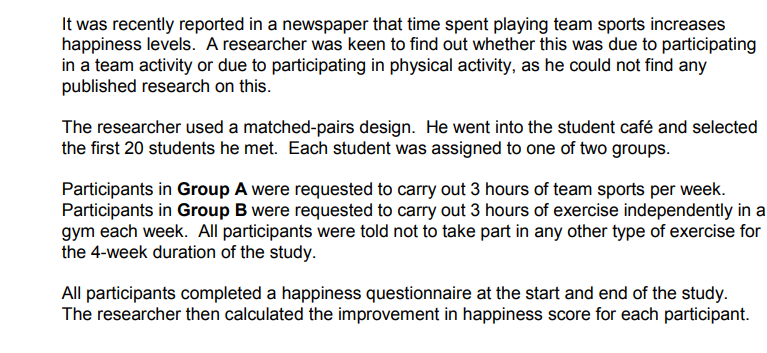
Identify one variable on which participants should be matched in this matched-pairs design. Explain how the researcher could assign matched participants to either Group A or Group B (4)
* participants could be matched on the number of hours of sport they typically do a week
* this could be measured by carrying out a questionnaire on the number of hours of sport they do each week
* then the Ps with the two highest score will be paired together then the next highest and so on until there are 10 pairs
* then in each pair they will be randomly allocated to group A or B so that there are 10 Ps in each group
* this could be measured by carrying out a questionnaire on the number of hours of sport they do each week
* then the Ps with the two highest score will be paired together then the next highest and so on until there are 10 pairs
* then in each pair they will be randomly allocated to group A or B so that there are 10 Ps in each group
65
New cards
Explain one strength of using a matched-pairs design rather than a repeated-measures design. (2)
there will be no order effects when using matched pairs because Ps only take part in one condition unlike repeated measures, such as tiredness or boredom. Therefore improving the validity of the results
66
New cards
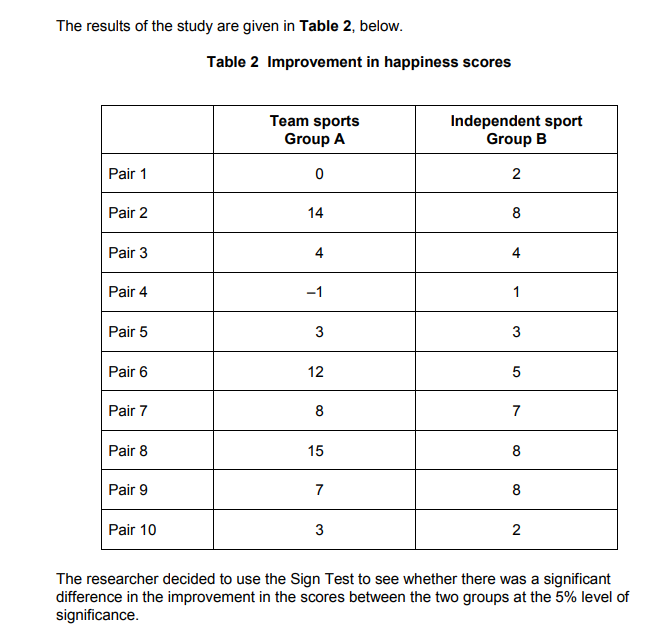
Calculate the value of S in this study. Show your workings (2)
3

67
New cards
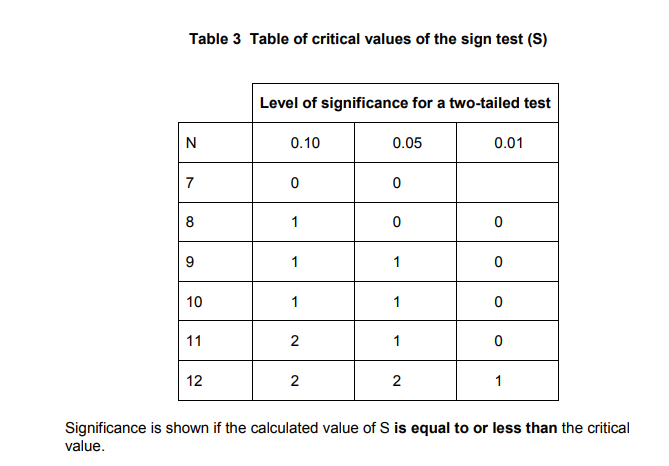
Explain whether or not there was a significant difference in the improvement in the scores between the two groups. Use your answer to Question 22 and Table 3. (2)
* S=3
* N= 8
* 5% significance
* critical value = 0
* not significant because s (3) is more than the critical value (0)
\
* N= 8
* 5% significance
* critical value = 0
* not significant because s (3) is more than the critical value (0)
\
68
New cards
Explain what it means for a test to have high concurrent validity (2)
it means that there is close agreement between the data produced by the new test compared to the established test. When the two sets of data produced by the two sets exceeds +0.8
69
New cards
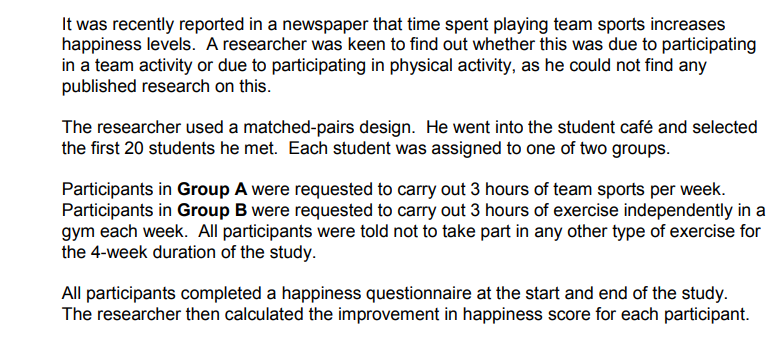
The questionnaire had high concurrent validity. Validity was still a concern because the researcher knew which participants were in each experimental group.
\
Explain how this could have affected the validity of the study. (4)
\
Explain how this could have affected the validity of the study. (4)
* knowing which experimental group each participant was in could lead to investigator effects
* the researcher may have unconsciously influenced the responses given by the participants
* For example, smiled more to participants
assigned to one of the groups whilst they were completing their happiness questionnaire
* this could have made them more likely to rate themselves happier
* therefore the increased happiness in the team sports group may therefore be due to investigator effects rather than the change in IV
* therefore reducing the validity of the results
* the researcher may have unconsciously influenced the responses given by the participants
* For example, smiled more to participants
assigned to one of the groups whilst they were completing their happiness questionnaire
* this could have made them more likely to rate themselves happier
* therefore the increased happiness in the team sports group may therefore be due to investigator effects rather than the change in IV
* therefore reducing the validity of the results
70
New cards
A psychology teacher read the researcher’s study on sport and happiness. She considered whether setting group tasks could improve her students’ level of happiness. She decided to conduct an independent groups experiment with 30 students taking A-level Psychology using the same happiness questionnaire.
Suggest an appropriate statistical test the psychology teacher could use to analyse the data. Justify your choice of test. (4)
Suggest an appropriate statistical test the psychology teacher could use to analyse the data. Justify your choice of test. (4)
* mann whitney
* test of difference
* independent groups therefore unrelated data
* ordinal data because answers to questionnaires can be ranked
* test of difference
* independent groups therefore unrelated data
* ordinal data because answers to questionnaires can be ranked
71
New cards
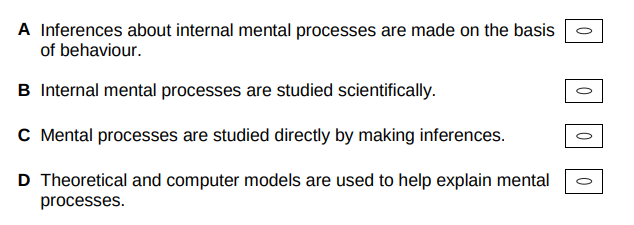
Which of the following statements about the cognitive approach is FALSE? (1)
C
72
New cards
We use schema when we process information from the world around us. Explain one reason why using schema might be useful when processing information from the world around us, and explain one reason why using schema might not be useful when processing information from the world around us. (4)
* a schema can help us predict what will happen in our world based on our experiences. For example we can know what to expect when going into a restaurant because of past experiences of going to restaurants
* however a schema could lead to inaccurate eye witness testimonies because we might inaccurately recall information based on what we expected to see rather than what actually happened
* however a schema could lead to inaccurate eye witness testimonies because we might inaccurately recall information based on what we expected to see rather than what actually happened
73
New cards
Jed was given a detention meaning that he would miss the football match after school. Jed felt extremely angry. Later that day, Jed was called in to the Head of Year’s office for kicking his locker at break time. Identify and explain the defence mechanism Jed was displaying. (3)
displacement
* The focus of a strong emotion is expressed to neutral/alternative person or object.
* his anger at missing the football match was displaced to the longer
* The focus of a strong emotion is expressed to neutral/alternative person or object.
* his anger at missing the football match was displaced to the longer
74
New cards
Outline the behaviourist approach. Compare the behaviourist approach with the biological approach. (16)
**behaviourist**
* The behaviourist approach is concerned with behaviour which can be observed and measured.
* it investigates mental processes of the mind
* it rejects introspection as it involves too many concepts that were vague and difficult to measure
* therefore behaviourists tried to maintain more control and objectivity within their research and relied on lab experiments as the best way to do this
* it includes classical and operant conditioning as forms of learning a behaviour
* classical conditioning is learning through association and operant conditioning is learning through reinforcement
**biological**
* the biological approach says that everything psychological is first biological, so to fully understand behaviour we must look to biological structures and processes in the body such as genes, neurochemistry, brain structure, genotype and phenotype, evolution and the nervous system
\
**Comparison:**
\
A similarity between these approaches is that they are both deterministic. For example, both approaches argue that behaviour is, to some extent, determined. Behaviourists argue that behaviour is determined by the environment and is a product of stimulus-response associations, while biological psychologists argue that behaviour is the product of internal biological factors (e.g. genes, hormones, neurotransmitters, etc.). As a result, it is clear that both approaches argue that behaviour is determined, although they differ in their belief about the origins of behaviour.
\
Furthermore, both approaches take a nomothetic approach when studying human behaviour. Both behaviourists and biological psychologists investigate behaviour in an attempt to create universal laws that apply to all human beings. Behaviourists argue that this is possible because human beings share similar physiologies, and behaviourists argue that this is possible because all behaviour is the result of learning and stimulus-response associations. Therefore, the aim of generating universal laws that apply to all humans is another similarity between the behaviourist and biological approaches.
\
However, the behaviourist approach and biological approach are different in their position on the nature-nurture debate. Behaviourist views rest firmly on the nurture side of the debate, and they argue that human beings are born a blank slate and that all behaviour is learned. Biological psychologists, on the other hand, would argue a nature-based view of behaviour. They posit that behaviour is the result of innate biological factors (e.g. genes, hormones, neurotransmitters. etc.) and is, therefore, the product of nature and not nurture. Therefore, despite their similarities in terms of determinism and their approach to investigation, the behaviourist and biological approaches are radically different in terms of their position on the nature-nurture debate.
* The behaviourist approach is concerned with behaviour which can be observed and measured.
* it investigates mental processes of the mind
* it rejects introspection as it involves too many concepts that were vague and difficult to measure
* therefore behaviourists tried to maintain more control and objectivity within their research and relied on lab experiments as the best way to do this
* it includes classical and operant conditioning as forms of learning a behaviour
* classical conditioning is learning through association and operant conditioning is learning through reinforcement
**biological**
* the biological approach says that everything psychological is first biological, so to fully understand behaviour we must look to biological structures and processes in the body such as genes, neurochemistry, brain structure, genotype and phenotype, evolution and the nervous system
\
**Comparison:**
\
A similarity between these approaches is that they are both deterministic. For example, both approaches argue that behaviour is, to some extent, determined. Behaviourists argue that behaviour is determined by the environment and is a product of stimulus-response associations, while biological psychologists argue that behaviour is the product of internal biological factors (e.g. genes, hormones, neurotransmitters, etc.). As a result, it is clear that both approaches argue that behaviour is determined, although they differ in their belief about the origins of behaviour.
\
Furthermore, both approaches take a nomothetic approach when studying human behaviour. Both behaviourists and biological psychologists investigate behaviour in an attempt to create universal laws that apply to all human beings. Behaviourists argue that this is possible because human beings share similar physiologies, and behaviourists argue that this is possible because all behaviour is the result of learning and stimulus-response associations. Therefore, the aim of generating universal laws that apply to all humans is another similarity between the behaviourist and biological approaches.
\
However, the behaviourist approach and biological approach are different in their position on the nature-nurture debate. Behaviourist views rest firmly on the nurture side of the debate, and they argue that human beings are born a blank slate and that all behaviour is learned. Biological psychologists, on the other hand, would argue a nature-based view of behaviour. They posit that behaviour is the result of innate biological factors (e.g. genes, hormones, neurotransmitters. etc.) and is, therefore, the product of nature and not nurture. Therefore, despite their similarities in terms of determinism and their approach to investigation, the behaviourist and biological approaches are radically different in terms of their position on the nature-nurture debate.
75
New cards
Give one difference between the autonomic nervous system and the somatic nervous system. (1)
the autonomic nervous system is involuntary whereas the somatic nervous system is under conscious control
76
New cards
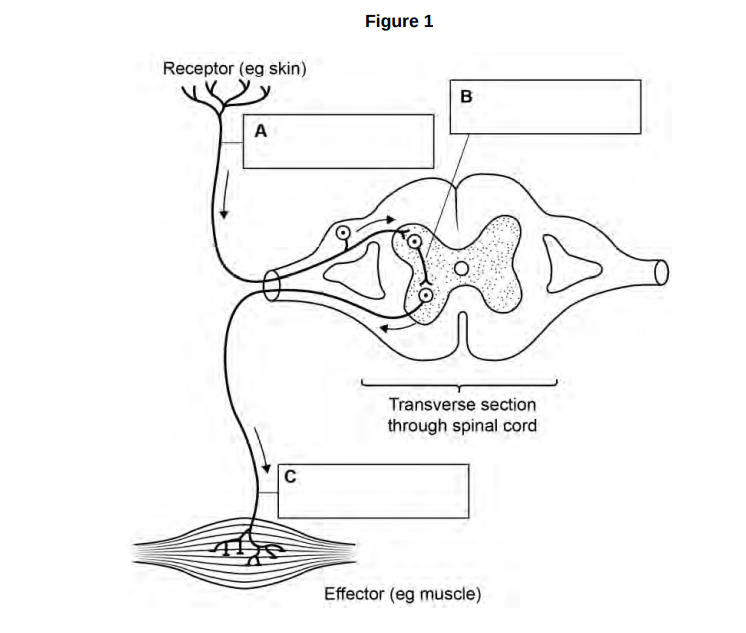
Name the types of neurons labelled A, B and C on Figure 1 below. Write your answers in the boxes provided (3)
A - sensory
B - motor
C - Motor
B - motor
C - Motor
77
New cards
Information can only travel in one direction at a synapse. Explain why neurons can only transmit information in one direction at a synapse. (3)
* due to the specific function of different parts of the neuron.
* At the end of the pre-synaptic neuron are synaptic vesicles that contain neurotransmitters.
* Neurotransmitters bind to specific receptor sites that are positioned at the start of the post-synaptic neuron that then become activated.
* Consequently, the information can only travel in this direction because the neurotransmitters are released from the vesicles at the end of the pre-synaptic neuron and bind to sites at the start of the post-synaptic neuron.
* This would make it impossible for information to flow in any other direction
* At the end of the pre-synaptic neuron are synaptic vesicles that contain neurotransmitters.
* Neurotransmitters bind to specific receptor sites that are positioned at the start of the post-synaptic neuron that then become activated.
* Consequently, the information can only travel in this direction because the neurotransmitters are released from the vesicles at the end of the pre-synaptic neuron and bind to sites at the start of the post-synaptic neuron.
* This would make it impossible for information to flow in any other direction
78
New cards
The fight or flight response enabled our ancestors to survive but can be less helpful in response to more modern stressors. Explain how the body responds during fight or flight and why this could be unhelpful in a driving test situation. (4)
the fight or flight response causes adrenaline to be released which can cause an increased production of sweat and faster heart and breathing rate which could be off putting and unhelpful during a driving test (e.g. sweaty hands may make it harder to grip the steering wheel).
79
New cards
Julia complains that her baby is sleeping all day and keeping her awake all night. Using your knowledge of research into exogenous zeitgebers, discuss what Julia could do to encourage her baby to sleep more at night. (8)
**AO1**
Exogenous zeitgebers are external cues that may affect our biological rhythms. For example the influence of light on our sleep/wake cycle. The siffre cave study showed that in the absence of external cues that the free running biological clock that controls the sleep wake cycle continued in a distinct cyclical pattern. Therefore showing that sleeping and wakefulness would seem to be determined by an interaction of internal and external factors.
Light is a key zeitgeber in humans as it can reset the main endogenous pacemaker such as the SCN in the sleep/wake cycle.
Social cues are also an important zeitgeber in the sleep wake cycle. For example in infants their initial sleep cycle is fairly random but by about 6 weeks most babies are entrained and their circadian rhythm begins. This is because of social cues such as their schedules imposed by parents like set mealtimes and bedtimes.
\
**AO2**
To encourage her baby to sleep more at night she could encourage her baby to eat at similar times to her and have set bedtimes. These social cues will help the baby have a circadian rhythm that means she won’t sleep all day. As well as that she should also make sure that she is kept in light during the day and a dark room at night as light is a key factor in determining the sleep wake cycle.
\
**AO3**
There is research to support the effects of social cues on our sleep/wake cycle. Research shows that adapting to local times for eating and sleeping rather than responding to your own feelings of hunger and fatigue it can change your circadian rhythms and beat jet lag when travelling long distances. Therefore showing that social cues such as eating times and bedtimes can influence and change our circadian rhythms.
\
There is research support for the role of light as an important exogenous zeitgeber. Vetter et al. (2011) conducted a longitudinal study over five weeks with volunteer participants who were either exposed to a ‘warm’ artificial light source or a ‘blue-enriched’ artificial light source, which was similar to daylight. Each participant was required to keep a daily record of their sleep patterns and wore equipment which measured how active they were during the daytime. It was found that participants in the first condition synchronised their circadian rhythm when dawn broke, which advanced every day, whereas those in the second group did not show this pattern and instead synchronised to their working hours at the office. This shows that light is indeed important in encouraging a regular circadian rhythm of the sleep/wake cycle and that the composition of light affects the SCN.
\
However the influence may be overstated. For example studies of individuals who live in Arctic regions where the doesn’t set during the summer months showed normal sleep patterns despite their prolonged exposure to light. Therefore suggesting that in some cases exogenous zeitgebers such as light may have little effect on our internal rhythm.
Exogenous zeitgebers are external cues that may affect our biological rhythms. For example the influence of light on our sleep/wake cycle. The siffre cave study showed that in the absence of external cues that the free running biological clock that controls the sleep wake cycle continued in a distinct cyclical pattern. Therefore showing that sleeping and wakefulness would seem to be determined by an interaction of internal and external factors.
Light is a key zeitgeber in humans as it can reset the main endogenous pacemaker such as the SCN in the sleep/wake cycle.
Social cues are also an important zeitgeber in the sleep wake cycle. For example in infants their initial sleep cycle is fairly random but by about 6 weeks most babies are entrained and their circadian rhythm begins. This is because of social cues such as their schedules imposed by parents like set mealtimes and bedtimes.
\
**AO2**
To encourage her baby to sleep more at night she could encourage her baby to eat at similar times to her and have set bedtimes. These social cues will help the baby have a circadian rhythm that means she won’t sleep all day. As well as that she should also make sure that she is kept in light during the day and a dark room at night as light is a key factor in determining the sleep wake cycle.
\
**AO3**
There is research to support the effects of social cues on our sleep/wake cycle. Research shows that adapting to local times for eating and sleeping rather than responding to your own feelings of hunger and fatigue it can change your circadian rhythms and beat jet lag when travelling long distances. Therefore showing that social cues such as eating times and bedtimes can influence and change our circadian rhythms.
\
There is research support for the role of light as an important exogenous zeitgeber. Vetter et al. (2011) conducted a longitudinal study over five weeks with volunteer participants who were either exposed to a ‘warm’ artificial light source or a ‘blue-enriched’ artificial light source, which was similar to daylight. Each participant was required to keep a daily record of their sleep patterns and wore equipment which measured how active they were during the daytime. It was found that participants in the first condition synchronised their circadian rhythm when dawn broke, which advanced every day, whereas those in the second group did not show this pattern and instead synchronised to their working hours at the office. This shows that light is indeed important in encouraging a regular circadian rhythm of the sleep/wake cycle and that the composition of light affects the SCN.
\
However the influence may be overstated. For example studies of individuals who live in Arctic regions where the doesn’t set during the summer months showed normal sleep patterns despite their prolonged exposure to light. Therefore suggesting that in some cases exogenous zeitgebers such as light may have little effect on our internal rhythm.
80
New cards
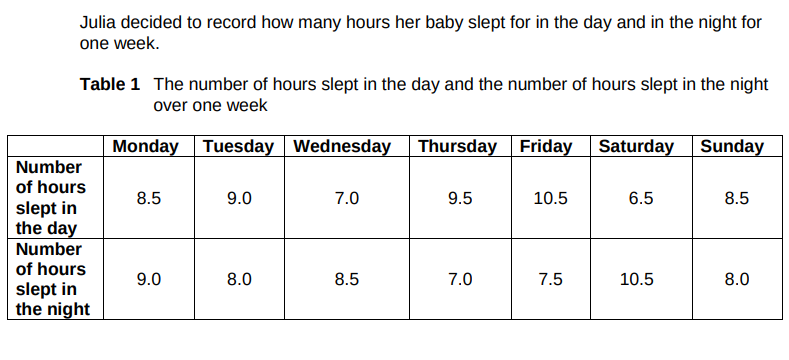
Calculate the mean number of hours slept in the night. Show your workings. Give your answer to two significant figures.(3)
8\.4
81
New cards
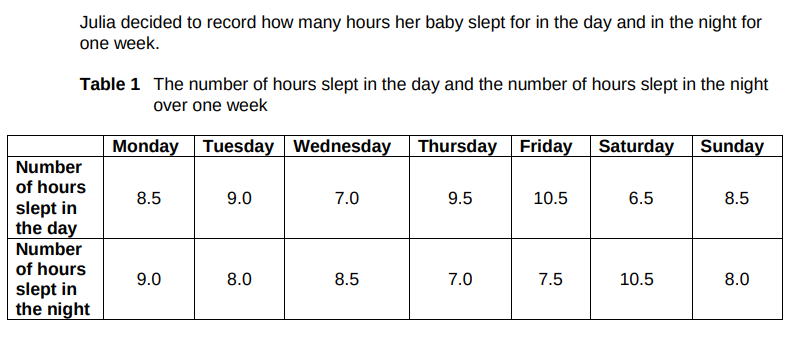
Explain one reason why the mean is the most appropriate measure of central tendency for this set of data. (2)
there are no extreme values (not skewed) so distortion will not be a problem with this data set
82
New cards

What is meant by a pilot study? Explain one possible reason why the psychologist decided to conduct a pilot study for this investigation. (3)
* Pilot studies are small-scale investigations conducted before research.
* the psychologist may have done a pilot study for this investigation to see if there needed to be any modifications to the design of the study
* for example whether the interview questions were relevant to dream content
* the psychologist may have done a pilot study for this investigation to see if there needed to be any modifications to the design of the study
* for example whether the interview questions were relevant to dream content
83
New cards

The interviews produced qualitative data. What is meant by qualitative data? Give one strength of collecting qualitative data in this study (2)
qualitative data is non numerical and descriptive dat. A strength is that you can collect more in depth and detailed information about dreams to get a deeper understanding of dream content
84
New cards

What are investigator effects? Suggest one way in which they could have been minimised box during the dream interviews. (3)
* investigator effects are any unintentional influence of the researcher’s behaviour that effects the participants data
* they can be minimised during the dream interviews by providing a standardised script for the interviewers to use so that they all asked the same questions in the same way to avoid any bias in the students’ responses
* they can be minimised during the dream interviews by providing a standardised script for the interviewers to use so that they all asked the same questions in the same way to avoid any bias in the students’ responses
85
New cards

Another researcher, who did not know the purpose of the study, carried out a content analysis of the interview data. Explain how this content analysis could have been conducted. (4)
* read and re read transcripts of the interview
* identify common themes that come up for example aggressive interactions
* then they would go over the transcripts again and count up/tally the number of times the common themes occurred
* this would then be sorted into categories
* and presented in a table or graph
* identify common themes that come up for example aggressive interactions
* then they would go over the transcripts again and count up/tally the number of times the common themes occurred
* this would then be sorted into categories
* and presented in a table or graph
86
New cards
The psychologist wanted to assess the reliability of the content analysis. Explain how the reliability of the content analysis could be assessed. (4)
they could use test retest reliability
* content analysis repeated on a second occasion using the same interview data
* compare the results of the two separate analysis (number of occurrences of each)
* researchers could calculate the correlation between the two ratings
* if there is a 0.8 correlation or above then it is reliable
* content analysis repeated on a second occasion using the same interview data
* compare the results of the two separate analysis (number of occurrences of each)
* researchers could calculate the correlation between the two ratings
* if there is a 0.8 correlation or above then it is reliable
87
New cards

A total of 375 dreams reported by males included social interaction. Use the data in Table 2 to calculate how many of these dreams reported by males were classified as aggressive. Show your workings. (2)
225
88
New cards
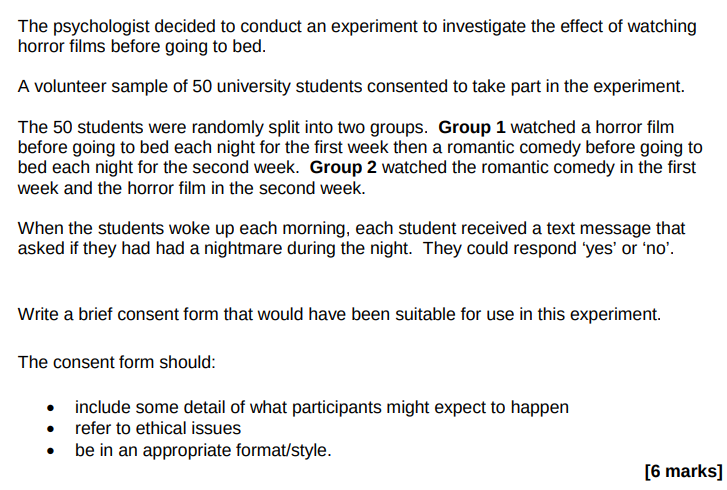
Dear Participant, you are volunteering to take part in a psychological research study about the effects of watching films before going to bed. In this study, you will watch a horror film or a romantic comedy film every night for one week each before going to bed. When you wake up each morning, you will receive a text message from the researcher asking you a question, to which there will be a yes/no response. The study will last for two weeks however you have the right to withdraw your participation from the research study at any time without explanation. You also have the right to ask that any data you have supplied to be withdrawn. You may ask any questions about the procedures before the study begins. The data we collect from you will be treated confidentially. Please sign below to consent that you agree to participate in this study.
89
New cards
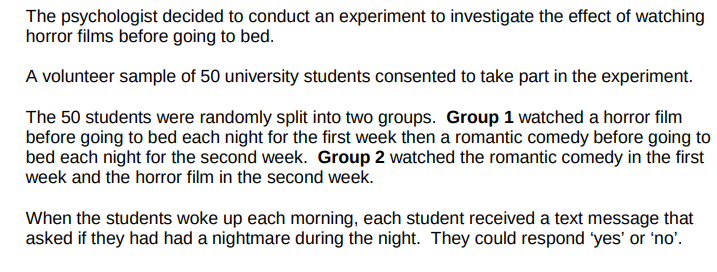
The psychologist proposed a directional hypothesis.
Write a directional hypothesis for this experiment. (3)
Write a directional hypothesis for this experiment. (3)
participants will report more nightmares after watching a horror film before bedtime than after watching a romantic comedy film before bedtime
90
New cards
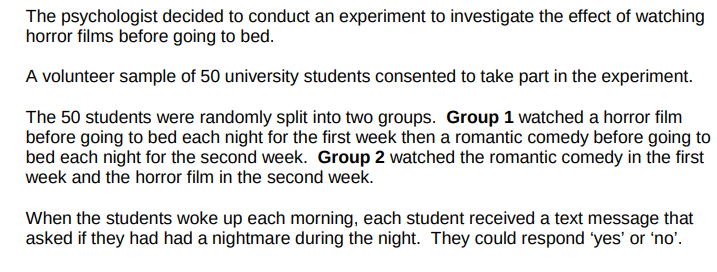
The psychologist used a repeated measures design in this experiment. Explain why it was important to use a repeated measures design in this case. (2)
because it is necessary to avoid individual differences. for example film viewing habits can effect frequencies of nightmares someone might normally experience.
91
New cards
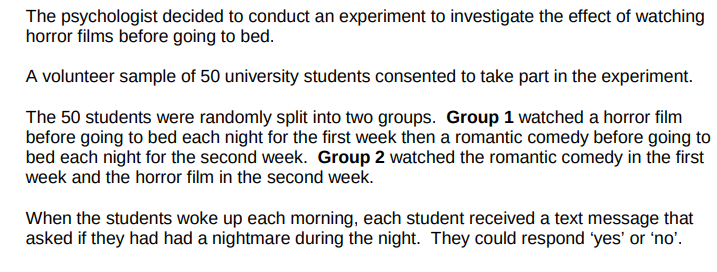
The psychologist used counterbalancing in this experiment. Explain why it was appropriate to use counterbalancing in this experiment. (2)
because it stops order effect occurring. For example if you saw the horror films in the first week you may still be thinking about them/have higher levels of fear in the second week, resulting in more nightmares.
92
New cards
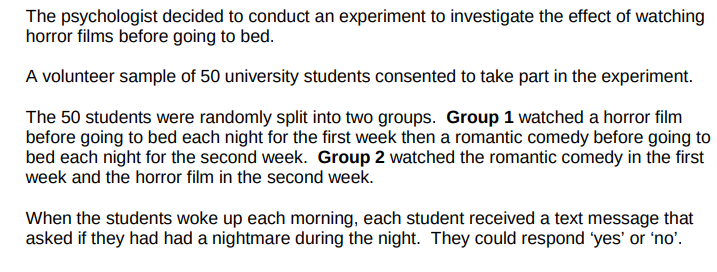
Explain how the box psychologist could have randomly split the sample of 50 students into the two groups. (3)
* all 50 Ps names are put into a hat
* a name is drawn at random and assigned to the first group
* then a second name is drawn at random and is assigned to the second group
* then this continues until all 50 Ps have been assigned to a group
* a name is drawn at random and assigned to the first group
* then a second name is drawn at random and is assigned to the second group
* then this continues until all 50 Ps have been assigned to a group
93
New cards

What do the mean and standard deviation values in Table 3 suggest about the effect of the type of film watched on the occurrence of nightmares? Justify your answer. (4)
mean:
* participants who watch horror films before going to bed report more nightmares then those who watch romantic comedies before bed
* because the mean number of nightmares reported is greater when horror films are watched than when romantic comedies are watched
\
standard deviation:
* there is a greater spread of scores in the horror film condition than in the romantic comedy condition
* standard deviation is greater when horror films are watched before going to bed than when romantic comedies are watched before going to bed.
* participants who watch horror films before going to bed report more nightmares then those who watch romantic comedies before bed
* because the mean number of nightmares reported is greater when horror films are watched than when romantic comedies are watched
\
standard deviation:
* there is a greater spread of scores in the horror film condition than in the romantic comedy condition
* standard deviation is greater when horror films are watched before going to bed than when romantic comedies are watched before going to bed.
94
New cards
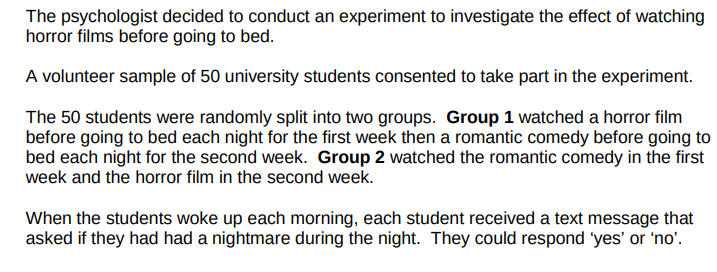
The psychologist found that the difference in the number of nightmares reported in the two conditions was significant at p
This means that the difference in the number of nightmares reported after watching horror films compared to romantic comedies is significant at 0.05 level. This means there is less than 5% likelihood (probability) that the difference was due to chance/due to something other than the IV.
95
New cards
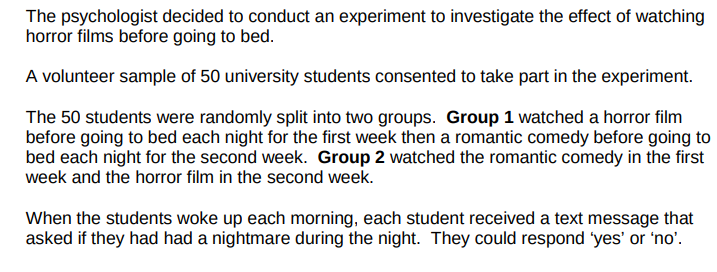
The psychologist was concerned about the validity of the experiment. Suggest one possible modification to the design of the experiment and explain how this might improve validity (3)
include more than one question in the text message to the students. This would make the aim of the experiment less obvious to guess which would in turn reduce demand characteristics and improve the validity of the experiment
96
New cards
Discuss research into one or more biological rhythms. (16 marks)
AO1
One biological rhythm is circadian rhythms. This is a pattern of behaviour that occurs or reoccurs approximately every 24 hours and which is set and reset by environmental light levels
Examples are: the sleep wake cycle, core body temperature and hormone production
We feel drowsy when its night time and alert during the day which demonstrates the effect of daylight (exogenous zeitgeber)
Light and darkness are the external signals that determine when we feel the need to sleep and wake up
Siffre's cave study - evidence of free running circadian rhythms He spent several extended periods underground to study the effects of his own biological rhythm. Deprived of exposure to natural light and sound but with access to food and drink He emerged in mid September believing it was August His free running biological rhythm settled down to one that was just over 24 hours though he did continue to fall asleep and wake up on a regular schedule
\
Research Support: Research has been conducted to investigate circadian rhythms and the effect of external cues like light on this system. Siffre (1975) found that the absence of external cues significantly altered his circadian rhythm: When he returned from an underground stay with no clocks or light, he believed the date to be a month earlier than it was. This suggests that his 24-hour sleep-wake cycle was increased by the lack of external cues, making him believe one day was longer than it was, and leading to his thinking that fewer days had passed.
Individual Differences: However, it is important to note the differences between individuals when it comes to circadian cycles. Duffy et al. (2001) found that ‘morning people’ prefer to rise and go to bed early (about 6 am and 10 pm) whereas ‘evening people’ prefer to wake and go to bed later (about 10 am and 1 am). This demonstrates that there may be innate individual differences in circadian rhythms, which suggests that researchers should focus on these differences during investigations.
Additionally, it has been suggested that temperature may be more important than light in determining circadian rhythms. Buhr et al. (2010) found that fluctuations in temperature set the timing of cells in the body and caused tissues and organs to become active or inactive. Buhr claimed that information about light levels is transformed into neural messages that set the body’s temperature. Body temperature fluctuates on a 24-hour circadian rhythm and even small changes in it can send a powerful signal to our body clocks. This shows that circadian rhythms are controlled and affected by several different factors, and suggests that a more holistic approach to research might be preferable.
One biological rhythm is circadian rhythms. This is a pattern of behaviour that occurs or reoccurs approximately every 24 hours and which is set and reset by environmental light levels
Examples are: the sleep wake cycle, core body temperature and hormone production
We feel drowsy when its night time and alert during the day which demonstrates the effect of daylight (exogenous zeitgeber)
Light and darkness are the external signals that determine when we feel the need to sleep and wake up
Siffre's cave study - evidence of free running circadian rhythms He spent several extended periods underground to study the effects of his own biological rhythm. Deprived of exposure to natural light and sound but with access to food and drink He emerged in mid September believing it was August His free running biological rhythm settled down to one that was just over 24 hours though he did continue to fall asleep and wake up on a regular schedule
\
Research Support: Research has been conducted to investigate circadian rhythms and the effect of external cues like light on this system. Siffre (1975) found that the absence of external cues significantly altered his circadian rhythm: When he returned from an underground stay with no clocks or light, he believed the date to be a month earlier than it was. This suggests that his 24-hour sleep-wake cycle was increased by the lack of external cues, making him believe one day was longer than it was, and leading to his thinking that fewer days had passed.
Individual Differences: However, it is important to note the differences between individuals when it comes to circadian cycles. Duffy et al. (2001) found that ‘morning people’ prefer to rise and go to bed early (about 6 am and 10 pm) whereas ‘evening people’ prefer to wake and go to bed later (about 10 am and 1 am). This demonstrates that there may be innate individual differences in circadian rhythms, which suggests that researchers should focus on these differences during investigations.
Additionally, it has been suggested that temperature may be more important than light in determining circadian rhythms. Buhr et al. (2010) found that fluctuations in temperature set the timing of cells in the body and caused tissues and organs to become active or inactive. Buhr claimed that information about light levels is transformed into neural messages that set the body’s temperature. Body temperature fluctuates on a 24-hour circadian rhythm and even small changes in it can send a powerful signal to our body clocks. This shows that circadian rhythms are controlled and affected by several different factors, and suggests that a more holistic approach to research might be preferable.
97
New cards
Discuss the effect of exogenous zeitgebers on the sleep wake cycle (16)
Exogenous zeitgebers are environmental cues, such as light, that helps regulate the biological clock in an organism
\
Light
Receptors in the SCN are sensitive to changes in light levels during the day and use this information to synchronise the activity of the body's organs and glandsLight resets the internal biological clock each day, keeping it on a 24-hour cycle
Social cues In infants, their sleep/wake cycle is affected by social cues such as mealtimes and bedtimes set by parents When someone experiences jet lag, by adapting to local times for eating and sleeping (rather than own feelings of hunger and fatigue) is an effective way of entrainment of circadian rhythms and beating jet lag when travelling long distances
\
The role of artificial light as a zeitgeber - Vetter et al (2011) investigated the importance of light in the regulation of the sleep/wake and activity/rest patterns of two groups of volunteer participants over 5 weeks One group remained in normal ‘warm’ artificial light and the other in ‘blue-enriched light’ which was close to daylight Over the course of the study sunrise advanced by 42 minutes Participants working under the warmer light synchronised their circadian rhythms each day with the natural light of dawn The participants who were exposed to blue-enriched light did not show the same 42 minute adjustment and instead synchronised their rhythms to office hours The results confirm that light is the dominant zeitgeber for the SCN and that its effectiveness depends on its spectral composition
\
Influence may be overstated Miles et al (1977) recount the story of a young man, blind from birth, with a circadian rhythm of 24.9 hours. Despite exposure to social cues, his sleep/wake cycle could not be adjusted and had to take sedatives and stimulants to regulate his cycle Also studies of people living in arctic regions where the sun doesn't set in winter show normal sleep patterns despite the prolonged exposure to light This suggests that there are occasions when exogenous zeitgebers may have little bearing on our internal rhythm
\
However, these studies are based off of a very small sample size, often only one person and unusual cases The sample isn’t representative, therefore cannot be generalised to the rest of the population
\
Light
Receptors in the SCN are sensitive to changes in light levels during the day and use this information to synchronise the activity of the body's organs and glandsLight resets the internal biological clock each day, keeping it on a 24-hour cycle
Social cues In infants, their sleep/wake cycle is affected by social cues such as mealtimes and bedtimes set by parents When someone experiences jet lag, by adapting to local times for eating and sleeping (rather than own feelings of hunger and fatigue) is an effective way of entrainment of circadian rhythms and beating jet lag when travelling long distances
\
The role of artificial light as a zeitgeber - Vetter et al (2011) investigated the importance of light in the regulation of the sleep/wake and activity/rest patterns of two groups of volunteer participants over 5 weeks One group remained in normal ‘warm’ artificial light and the other in ‘blue-enriched light’ which was close to daylight Over the course of the study sunrise advanced by 42 minutes Participants working under the warmer light synchronised their circadian rhythms each day with the natural light of dawn The participants who were exposed to blue-enriched light did not show the same 42 minute adjustment and instead synchronised their rhythms to office hours The results confirm that light is the dominant zeitgeber for the SCN and that its effectiveness depends on its spectral composition
\
Influence may be overstated Miles et al (1977) recount the story of a young man, blind from birth, with a circadian rhythm of 24.9 hours. Despite exposure to social cues, his sleep/wake cycle could not be adjusted and had to take sedatives and stimulants to regulate his cycle Also studies of people living in arctic regions where the sun doesn't set in winter show normal sleep patterns despite the prolonged exposure to light This suggests that there are occasions when exogenous zeitgebers may have little bearing on our internal rhythm
\
However, these studies are based off of a very small sample size, often only one person and unusual cases The sample isn’t representative, therefore cannot be generalised to the rest of the population
98
New cards
Annie suffered a stroke at the age of 55. After the stroke she was paralysed down her right side, though she could move her left arm and leg easily. Annie could clearly understand what was said to her, but was unable to produce any speech. Discuss how knowledge of hemispheric lateralisation and language centres in the brain has helped our understanding of cases such as Annie’s. Refer to Annie’s case in your answer. (16)
* Hemispheric lateralisation = the idea that the two hemispheres (halves) of the brain are functionally different and that certain mental processes and behaviours are mainly controlled by one hemisphere rather than the other.
* Mental processes in the brain are mainly specialised to either the left or right hemisphere
* One side of the brain controls the other side of the body
* Language areas of the brain include the Broca's area which is the posterior portion of the frontal lobe in the left hemisphere responsible for speech production
* Wernicke's area is located in the posterior portion of the left temporal lobe for language comprehension
\
* Annie suffered a stroke which damaged the left hemisphere of the brain as she can’t move her right side, and the left side of the brain is responsible for the right side of the body
* Because the left side of the brain was damaged, her broca's area was damaged which was why she was unable to produce speech
* But she could understand speech because her right side of the brain was undamaged where the wernicke's area is located for speech comprehension.
\
* There is research to support hemispheric lateralisation.
* Sperry and Gazzaniga carried out investigations on split brain patients whose corpus callosum had been cut. The researchers were thus able to isolate each hemisphere to observe its function.
* They found that when patients were presented with a word in their right visual field, they could say what they saw; they could not say what they saw when presented with a word in their left visual field.
* From these findings, it was concluded that language functions are located only in the left hemisphere; otherwise, the patient would be able to say what they saw in their left visual field (which goes to the right hemisphere).
* This research confirms what Annie’s brain damage demonstrated: that language is processed in the left hemisphere and that each hemisphere controls the visual/motor input of its opposite side
\n
* However, Turk et al. found evidence of the right hemisphere’s ability to process and produce speech. They studied J.W, a patient who suffered damage to the left hemisphere but developed the capacity to speak in the right hemisphere.
* This indicates the brain’s ability to adapt significantly following brain damage, and suggests that Annie may well be able to recover her speech capability after a period of functional recovery
\n
* A limitation is that almost all of the research takes place with case studies or really small sample sizes.
* They are often an extraordinary case e.g brain damage/trauma
* Therefore the results from these studies cannot be generalised to the rest of the population, therefore no that useful
\
* There is evidence to suggest that lateralisation of function changes with age
* Szaflarski et al. (2006) found that
* language becomes more lateralized to the left hemisphere until the age of 25, at which point lateralisation starts to decrease.
* This demonstrates that while lateralisation may be predominately found in the left hemisphere until the age of 25, it becomes less lateralized with age
* as Annie was 55 when her stroke took place it is reasonable to assume that her language centre was less lateralized as a result of her age
* Mental processes in the brain are mainly specialised to either the left or right hemisphere
* One side of the brain controls the other side of the body
* Language areas of the brain include the Broca's area which is the posterior portion of the frontal lobe in the left hemisphere responsible for speech production
* Wernicke's area is located in the posterior portion of the left temporal lobe for language comprehension
\
* Annie suffered a stroke which damaged the left hemisphere of the brain as she can’t move her right side, and the left side of the brain is responsible for the right side of the body
* Because the left side of the brain was damaged, her broca's area was damaged which was why she was unable to produce speech
* But she could understand speech because her right side of the brain was undamaged where the wernicke's area is located for speech comprehension.
\
* There is research to support hemispheric lateralisation.
* Sperry and Gazzaniga carried out investigations on split brain patients whose corpus callosum had been cut. The researchers were thus able to isolate each hemisphere to observe its function.
* They found that when patients were presented with a word in their right visual field, they could say what they saw; they could not say what they saw when presented with a word in their left visual field.
* From these findings, it was concluded that language functions are located only in the left hemisphere; otherwise, the patient would be able to say what they saw in their left visual field (which goes to the right hemisphere).
* This research confirms what Annie’s brain damage demonstrated: that language is processed in the left hemisphere and that each hemisphere controls the visual/motor input of its opposite side
\n
* However, Turk et al. found evidence of the right hemisphere’s ability to process and produce speech. They studied J.W, a patient who suffered damage to the left hemisphere but developed the capacity to speak in the right hemisphere.
* This indicates the brain’s ability to adapt significantly following brain damage, and suggests that Annie may well be able to recover her speech capability after a period of functional recovery
\n
* A limitation is that almost all of the research takes place with case studies or really small sample sizes.
* They are often an extraordinary case e.g brain damage/trauma
* Therefore the results from these studies cannot be generalised to the rest of the population, therefore no that useful
\
* There is evidence to suggest that lateralisation of function changes with age
* Szaflarski et al. (2006) found that
* language becomes more lateralized to the left hemisphere until the age of 25, at which point lateralisation starts to decrease.
* This demonstrates that while lateralisation may be predominately found in the left hemisphere until the age of 25, it becomes less lateralized with age
* as Annie was 55 when her stroke took place it is reasonable to assume that her language centre was less lateralized as a result of her age
99
New cards
Bella completes a quiz in her magazine and announces that she is ‘left brained’. “That’s just silly”, Cara says. “You cannot just be ‘left brained’, the whole brain works together to carry out functions.” “It’s not silly!” Bella replies. “It says here that the left brain is responsible for speech and language.”
Discuss research into localisation of function in the brain and/or hemispheric lateralisation. Refer to Bella and Cara’s discussion in your answer. (16)
Discuss research into localisation of function in the brain and/or hemispheric lateralisation. Refer to Bella and Cara’s discussion in your answer. (16)
Hemispheric lateralisation is the theory that the two halves of the cortex of the brain are functionally different and that each hemisphere has functional specialisations. The two hemispheres themselves are connected through a set of nerve fibres known as the corpus callosum, these fibres facilitate the communication between the left and right hemispheres of the brain. To research whether the left and right hemispheres of the brain have functional specialisms is difficult as the corpus callosum allows communication between the two hemispheres. This has led researchers to seek out patients whose corpus callosums, whether through, injury, genetics or surgery are not in-tact. For example, the research from Sperry’s select case of epileptic patients who had their corpus callosum removed to reduce seizures. Sperry’s research was able to demonstrate the functional speciality of the left and right hemispheres through the use of specialist equipment called a tachistoscope. Sperry presented words to either the left of right visual field. Owed to the contralateral configuration of the brain the words presented to the LVF would be processed in the right hemisphere and the words form the RVF in the left hemisphere. Sperry’s patients were able to verbally state words appearing to their LVF but not their right. This aligns with Broca’s assertion that the left hemisphere is responsible for language and speech.
\n It is clear from Kieran’s comments about the left brain being responsible for certain tasks that he is referring to hemispheric lateralisation, that the brain is lateralised and certain sides of the cortex are individually responsible for certain function, such as Kieran says, the left hemisphere for speech and language where Broca and Wernicke’s area are located. Sam on the other hand is referring to how the two parts of the cortex, the left and right hemisphere are able to communicate with each other through a system of fibres known as the corpus callosum, when he refers to the whole brain working together.
\n Although the work of Sperry and Broca supports the theory of hemispheric lateralisation, there is research that contradicts these findings. Interestingly the case study of Kim Peek, who was born without a corpus callosum demonstrated the Peek was able to read out-loud from a book from the right and left pages at the same time, if language was, like Broca and Sperry had argued, lateralised to the left hemisphere Peek would have only been able to read aloud the words from the right page. This criticism is further reinforced by Turn (2002) who discovered a patient who suffered damage to the left hemisphere, but developed the capacity to speak from the right hemisphere, eventually leading to the ability to speak about information presented to either side of the brain. This points to the fact that through a process of functionally recovery, lateralised functions may appear on opposing sides after injury.
\
Another factor to consider in respect to hemispheric lateralisation is the degree to which the brain is lateralised. There is research by Shaywitz 1995 for example to support the idea that in males the brain may be more lateralised for language than in females. This is further supported by Baron Cohen 2005 who asserted that these gender differences in lateralisation may also contribute to the incidence of disorders such as ASD. Both of these pieces of research serve to demonstrate that hemispheric lateralisation is much more complex that Sperry and Broca’s research indicates.
\n It is clear from Kieran’s comments about the left brain being responsible for certain tasks that he is referring to hemispheric lateralisation, that the brain is lateralised and certain sides of the cortex are individually responsible for certain function, such as Kieran says, the left hemisphere for speech and language where Broca and Wernicke’s area are located. Sam on the other hand is referring to how the two parts of the cortex, the left and right hemisphere are able to communicate with each other through a system of fibres known as the corpus callosum, when he refers to the whole brain working together.
\n Although the work of Sperry and Broca supports the theory of hemispheric lateralisation, there is research that contradicts these findings. Interestingly the case study of Kim Peek, who was born without a corpus callosum demonstrated the Peek was able to read out-loud from a book from the right and left pages at the same time, if language was, like Broca and Sperry had argued, lateralised to the left hemisphere Peek would have only been able to read aloud the words from the right page. This criticism is further reinforced by Turn (2002) who discovered a patient who suffered damage to the left hemisphere, but developed the capacity to speak from the right hemisphere, eventually leading to the ability to speak about information presented to either side of the brain. This points to the fact that through a process of functionally recovery, lateralised functions may appear on opposing sides after injury.
\
Another factor to consider in respect to hemispheric lateralisation is the degree to which the brain is lateralised. There is research by Shaywitz 1995 for example to support the idea that in males the brain may be more lateralised for language than in females. This is further supported by Baron Cohen 2005 who asserted that these gender differences in lateralisation may also contribute to the incidence of disorders such as ASD. Both of these pieces of research serve to demonstrate that hemispheric lateralisation is much more complex that Sperry and Broca’s research indicates.
100
New cards
Outline and evaluate research evidence for plasticity and/or functional recovery after trauma. (16)
The brain is not a static organ, and the functions and processes of the brain can change as a result of experience and injury. Brain plasticity refers to the brain’s ability to change and adapt because of experience. Research has demonstrated that the brain continues to create new neural pathways and alter existing ones in response to changing experiences.
\
The brain also appears to show evidence of functional recovery: the transfer of functions from a damaged area of the brain after trauma to other undamaged areas. It can do this through a process termed neuronal unmasking where ‘dormant’ synapses (which have not received enough input to be active) open connections to compensate for a nearby damaged area of the brain. This allows new connections in the brain to be activated, thus recovering any damage occurring in specific regions.
\
Kuhn et al. found a significant increase in grey matter in various regions of the brain after participants played video games for 30 minutes a day over a two-month period. Similarly, Davidson et al. demonstrated the permanent change in the brain generated by prolonged meditation: Buddhist monks who meditated frequently had a much greater activation of gamma waves (which coordinate neural activity) than did students with no experience of meditation. These two studies highlight the idea of plasticity and the brain’s ability to adapt as a result of new experience, whether it’s video games or mediation.
\n
There is further research to support the notion of brain plasticity. Maguire et al. found that the posterior hippocampal volume of London taxi drivers’ brains was positively correlated with their time as a taxi driver and that there were significant differences between the taxi drivers’ brains and those of controls. This shows that the brain can permanently change in response to frequent exposure to a particular task.
\n
There is research to support the claim for functional recovery. Taijiri et al. (2013) found that stem cells provided to rats after brain trauma showed a clear development of neuron-like cells in the area of injury. This demonstrates the ability of the brain to create new connections using neurons manufactured by stem cells.
\n
While there is evidence for functional recovery, it is possible that this ability can deteriorate with age. Elbert et al. concluded that the capacity for neural reorganisation is much greater in children than in adults, meaning that neural regeneration is less effective in older brains. This may explain why adults find change more demanding than do young people. Therefore, we must consider individual differences when assessing the likelihood of functional recovery in the brain after trauma.
\n A final strength of research examining plasticity and functional recovery is the application of the findings to the field of neurorehabilitation. Understanding the processes of plasticity and functional recovery led to the development of neurorehabilitation which uses motor therapy and electrical stimulation of the brain to counter the negative effects and deficits in motor and cognitive functions following accidents, injuries and/or strokes. This demonstrates the positive application of research in this area to help improve the cognitive functions of people suffering from injuries.
\n
\
\
The brain also appears to show evidence of functional recovery: the transfer of functions from a damaged area of the brain after trauma to other undamaged areas. It can do this through a process termed neuronal unmasking where ‘dormant’ synapses (which have not received enough input to be active) open connections to compensate for a nearby damaged area of the brain. This allows new connections in the brain to be activated, thus recovering any damage occurring in specific regions.
\
Kuhn et al. found a significant increase in grey matter in various regions of the brain after participants played video games for 30 minutes a day over a two-month period. Similarly, Davidson et al. demonstrated the permanent change in the brain generated by prolonged meditation: Buddhist monks who meditated frequently had a much greater activation of gamma waves (which coordinate neural activity) than did students with no experience of meditation. These two studies highlight the idea of plasticity and the brain’s ability to adapt as a result of new experience, whether it’s video games or mediation.
\n
There is further research to support the notion of brain plasticity. Maguire et al. found that the posterior hippocampal volume of London taxi drivers’ brains was positively correlated with their time as a taxi driver and that there were significant differences between the taxi drivers’ brains and those of controls. This shows that the brain can permanently change in response to frequent exposure to a particular task.
\n
There is research to support the claim for functional recovery. Taijiri et al. (2013) found that stem cells provided to rats after brain trauma showed a clear development of neuron-like cells in the area of injury. This demonstrates the ability of the brain to create new connections using neurons manufactured by stem cells.
\n
While there is evidence for functional recovery, it is possible that this ability can deteriorate with age. Elbert et al. concluded that the capacity for neural reorganisation is much greater in children than in adults, meaning that neural regeneration is less effective in older brains. This may explain why adults find change more demanding than do young people. Therefore, we must consider individual differences when assessing the likelihood of functional recovery in the brain after trauma.
\n A final strength of research examining plasticity and functional recovery is the application of the findings to the field of neurorehabilitation. Understanding the processes of plasticity and functional recovery led to the development of neurorehabilitation which uses motor therapy and electrical stimulation of the brain to counter the negative effects and deficits in motor and cognitive functions following accidents, injuries and/or strokes. This demonstrates the positive application of research in this area to help improve the cognitive functions of people suffering from injuries.
\n
\